Analyzing Impact of Macro Environment and Stakeholder Analysis on Uber
VerifiedAdded on 2022/12/27
|21
|6396
|1
AI Summary
This report analyzes the impact and influence of macro environment on Uber, including PESTLE analysis and stakeholder analysis. It also assesses the internal environment and capabilities of Uber using VRIO analysis and McKinsey's 7S model.
Contribute Materials
Your contribution can guide someone’s learning journey. Share your
documents today.
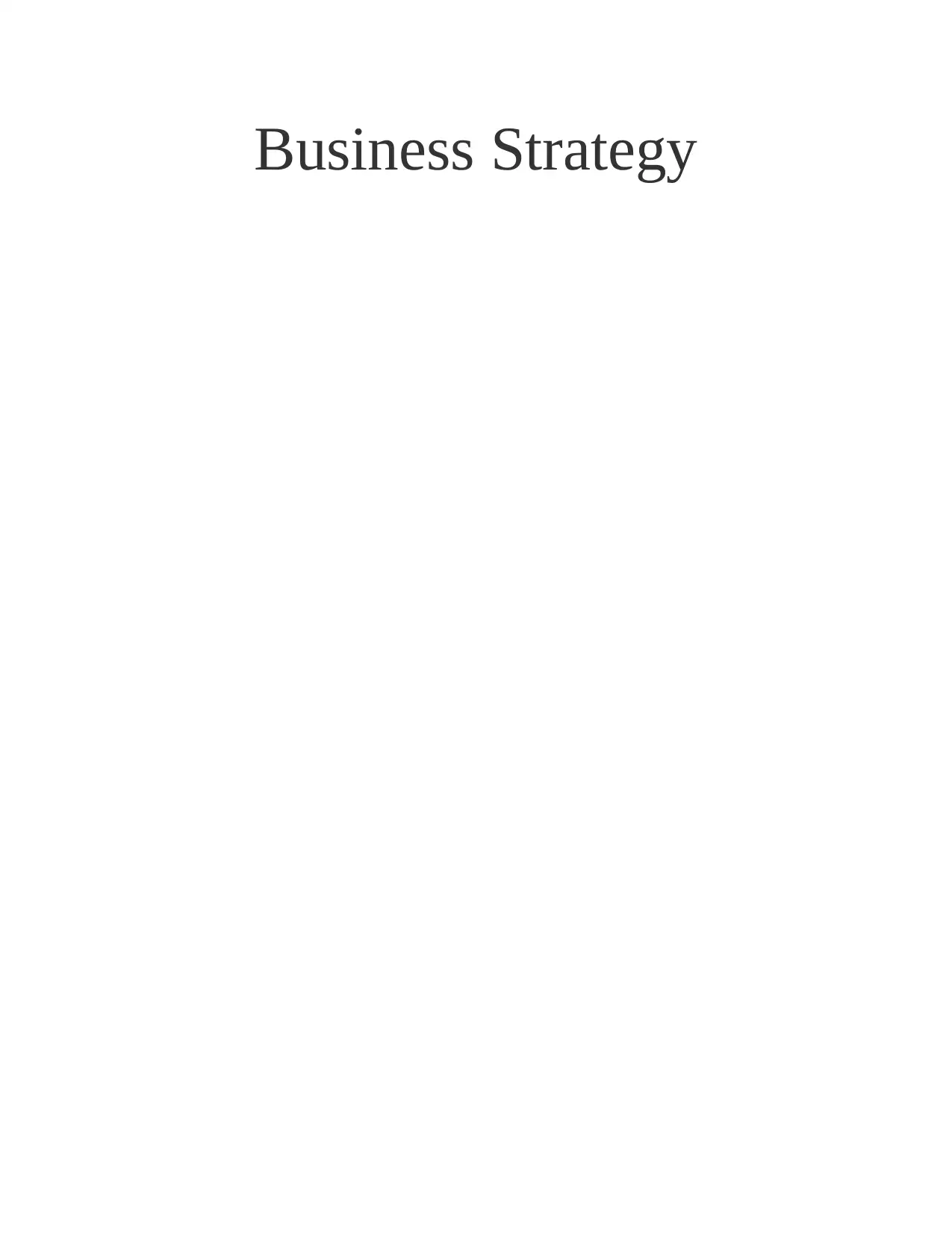
Business Strategy
Secure Best Marks with AI Grader
Need help grading? Try our AI Grader for instant feedback on your assignments.
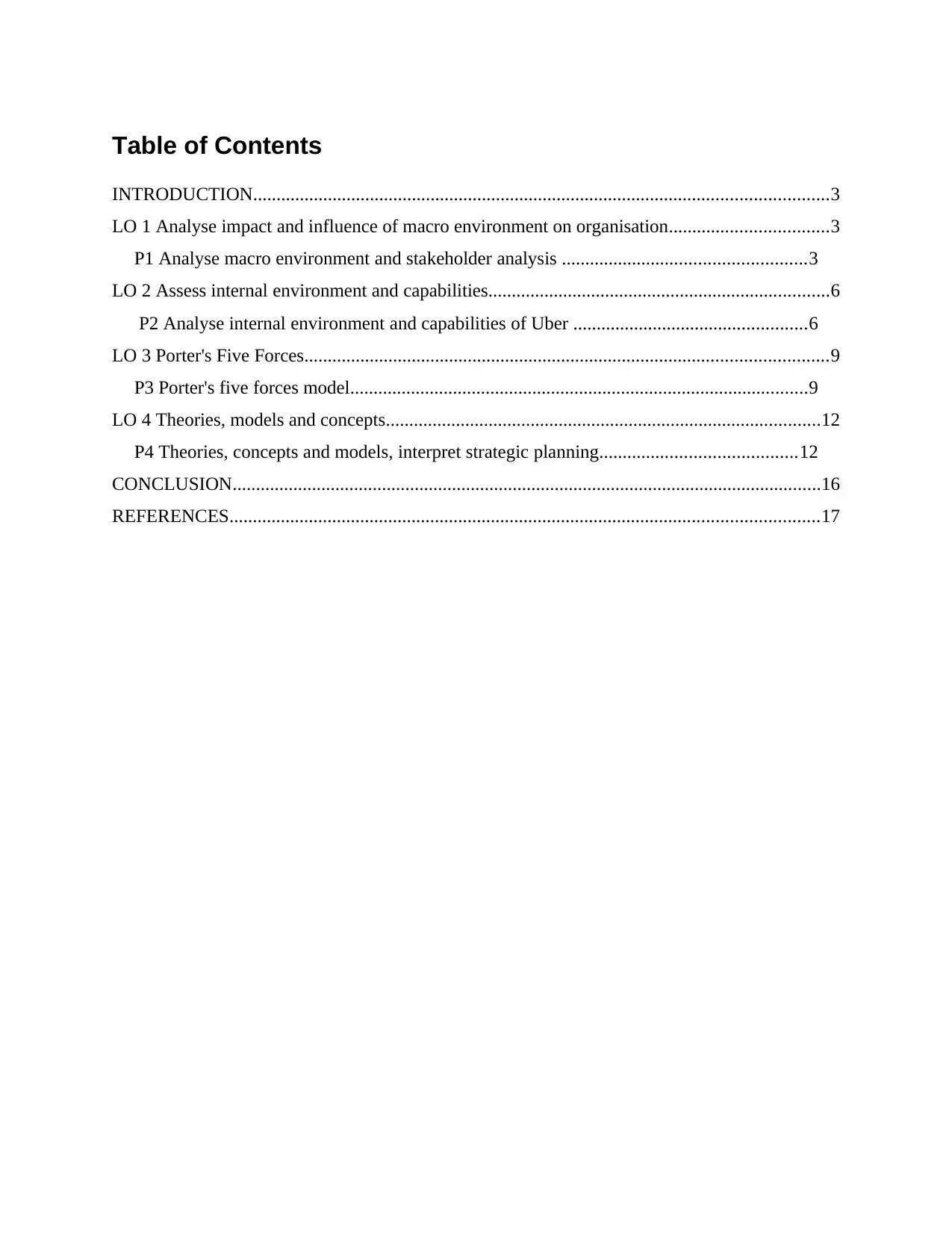
Table of Contents
INTRODUCTION...........................................................................................................................3
LO 1 Analyse impact and influence of macro environment on organisation..................................3
P1 Analyse macro environment and stakeholder analysis ....................................................3
LO 2 Assess internal environment and capabilities.........................................................................6
P2 Analyse internal environment and capabilities of Uber ..................................................6
LO 3 Porter's Five Forces................................................................................................................9
P3 Porter's five forces model..................................................................................................9
LO 4 Theories, models and concepts.............................................................................................12
P4 Theories, concepts and models, interpret strategic planning..........................................12
CONCLUSION..............................................................................................................................16
REFERENCES..............................................................................................................................17
INTRODUCTION...........................................................................................................................3
LO 1 Analyse impact and influence of macro environment on organisation..................................3
P1 Analyse macro environment and stakeholder analysis ....................................................3
LO 2 Assess internal environment and capabilities.........................................................................6
P2 Analyse internal environment and capabilities of Uber ..................................................6
LO 3 Porter's Five Forces................................................................................................................9
P3 Porter's five forces model..................................................................................................9
LO 4 Theories, models and concepts.............................................................................................12
P4 Theories, concepts and models, interpret strategic planning..........................................12
CONCLUSION..............................................................................................................................16
REFERENCES..............................................................................................................................17
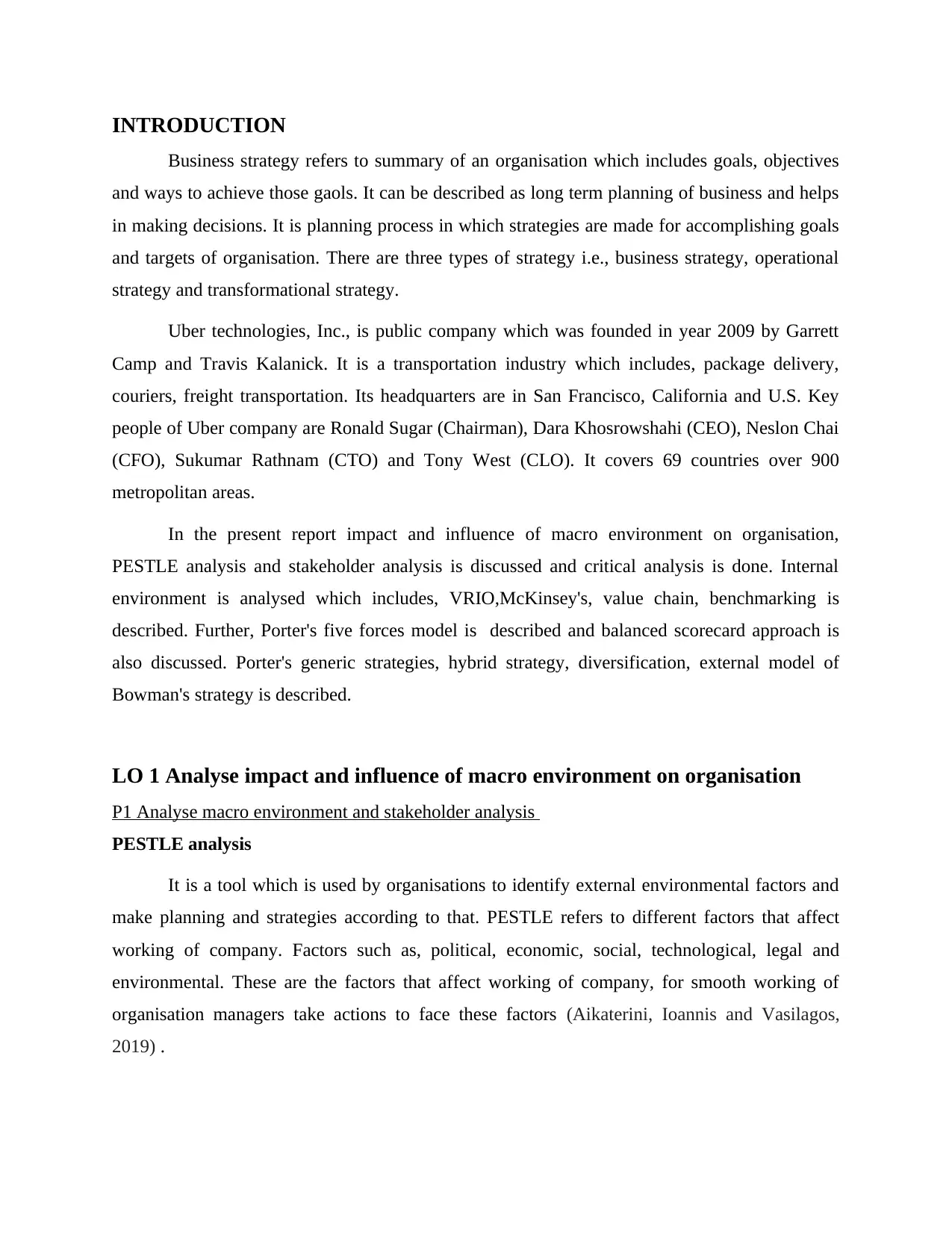
INTRODUCTION
Business strategy refers to summary of an organisation which includes goals, objectives
and ways to achieve those gaols. It can be described as long term planning of business and helps
in making decisions. It is planning process in which strategies are made for accomplishing goals
and targets of organisation. There are three types of strategy i.e., business strategy, operational
strategy and transformational strategy.
Uber technologies, Inc., is public company which was founded in year 2009 by Garrett
Camp and Travis Kalanick. It is a transportation industry which includes, package delivery,
couriers, freight transportation. Its headquarters are in San Francisco, California and U.S. Key
people of Uber company are Ronald Sugar (Chairman), Dara Khosrowshahi (CEO), Neslon Chai
(CFO), Sukumar Rathnam (CTO) and Tony West (CLO). It covers 69 countries over 900
metropolitan areas.
In the present report impact and influence of macro environment on organisation,
PESTLE analysis and stakeholder analysis is discussed and critical analysis is done. Internal
environment is analysed which includes, VRIO,McKinsey's, value chain, benchmarking is
described. Further, Porter's five forces model is described and balanced scorecard approach is
also discussed. Porter's generic strategies, hybrid strategy, diversification, external model of
Bowman's strategy is described.
LO 1 Analyse impact and influence of macro environment on organisation
P1 Analyse macro environment and stakeholder analysis
PESTLE analysis
It is a tool which is used by organisations to identify external environmental factors and
make planning and strategies according to that. PESTLE refers to different factors that affect
working of company. Factors such as, political, economic, social, technological, legal and
environmental. These are the factors that affect working of company, for smooth working of
organisation managers take actions to face these factors (Aikaterini, Ioannis and Vasilagos,
2019) .
Business strategy refers to summary of an organisation which includes goals, objectives
and ways to achieve those gaols. It can be described as long term planning of business and helps
in making decisions. It is planning process in which strategies are made for accomplishing goals
and targets of organisation. There are three types of strategy i.e., business strategy, operational
strategy and transformational strategy.
Uber technologies, Inc., is public company which was founded in year 2009 by Garrett
Camp and Travis Kalanick. It is a transportation industry which includes, package delivery,
couriers, freight transportation. Its headquarters are in San Francisco, California and U.S. Key
people of Uber company are Ronald Sugar (Chairman), Dara Khosrowshahi (CEO), Neslon Chai
(CFO), Sukumar Rathnam (CTO) and Tony West (CLO). It covers 69 countries over 900
metropolitan areas.
In the present report impact and influence of macro environment on organisation,
PESTLE analysis and stakeholder analysis is discussed and critical analysis is done. Internal
environment is analysed which includes, VRIO,McKinsey's, value chain, benchmarking is
described. Further, Porter's five forces model is described and balanced scorecard approach is
also discussed. Porter's generic strategies, hybrid strategy, diversification, external model of
Bowman's strategy is described.
LO 1 Analyse impact and influence of macro environment on organisation
P1 Analyse macro environment and stakeholder analysis
PESTLE analysis
It is a tool which is used by organisations to identify external environmental factors and
make planning and strategies according to that. PESTLE refers to different factors that affect
working of company. Factors such as, political, economic, social, technological, legal and
environmental. These are the factors that affect working of company, for smooth working of
organisation managers take actions to face these factors (Aikaterini, Ioannis and Vasilagos,
2019) .
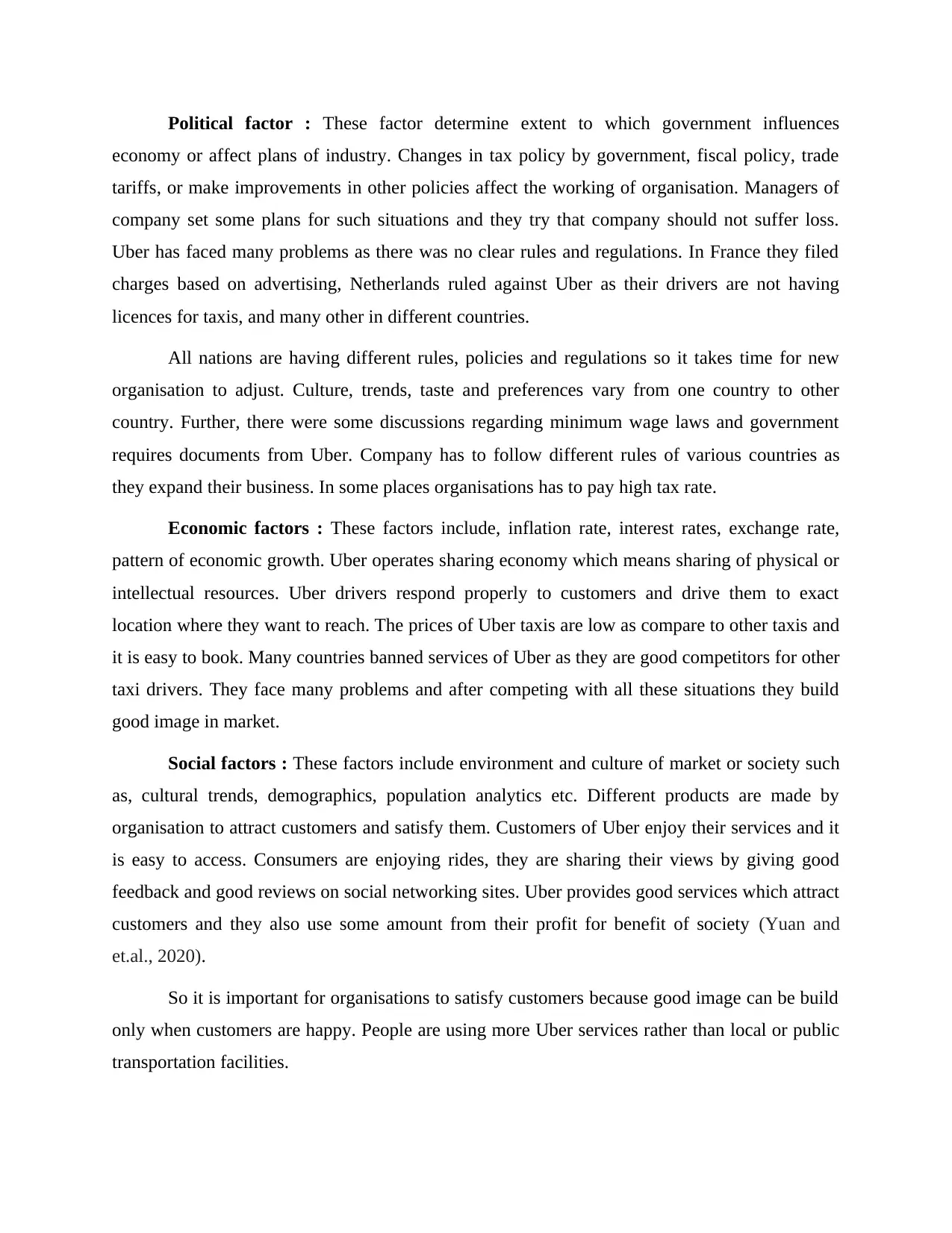
Political factor : These factor determine extent to which government influences
economy or affect plans of industry. Changes in tax policy by government, fiscal policy, trade
tariffs, or make improvements in other policies affect the working of organisation. Managers of
company set some plans for such situations and they try that company should not suffer loss.
Uber has faced many problems as there was no clear rules and regulations. In France they filed
charges based on advertising, Netherlands ruled against Uber as their drivers are not having
licences for taxis, and many other in different countries.
All nations are having different rules, policies and regulations so it takes time for new
organisation to adjust. Culture, trends, taste and preferences vary from one country to other
country. Further, there were some discussions regarding minimum wage laws and government
requires documents from Uber. Company has to follow different rules of various countries as
they expand their business. In some places organisations has to pay high tax rate.
Economic factors : These factors include, inflation rate, interest rates, exchange rate,
pattern of economic growth. Uber operates sharing economy which means sharing of physical or
intellectual resources. Uber drivers respond properly to customers and drive them to exact
location where they want to reach. The prices of Uber taxis are low as compare to other taxis and
it is easy to book. Many countries banned services of Uber as they are good competitors for other
taxi drivers. They face many problems and after competing with all these situations they build
good image in market.
Social factors : These factors include environment and culture of market or society such
as, cultural trends, demographics, population analytics etc. Different products are made by
organisation to attract customers and satisfy them. Customers of Uber enjoy their services and it
is easy to access. Consumers are enjoying rides, they are sharing their views by giving good
feedback and good reviews on social networking sites. Uber provides good services which attract
customers and they also use some amount from their profit for benefit of society (Yuan and
et.al., 2020).
So it is important for organisations to satisfy customers because good image can be build
only when customers are happy. People are using more Uber services rather than local or public
transportation facilities.
economy or affect plans of industry. Changes in tax policy by government, fiscal policy, trade
tariffs, or make improvements in other policies affect the working of organisation. Managers of
company set some plans for such situations and they try that company should not suffer loss.
Uber has faced many problems as there was no clear rules and regulations. In France they filed
charges based on advertising, Netherlands ruled against Uber as their drivers are not having
licences for taxis, and many other in different countries.
All nations are having different rules, policies and regulations so it takes time for new
organisation to adjust. Culture, trends, taste and preferences vary from one country to other
country. Further, there were some discussions regarding minimum wage laws and government
requires documents from Uber. Company has to follow different rules of various countries as
they expand their business. In some places organisations has to pay high tax rate.
Economic factors : These factors include, inflation rate, interest rates, exchange rate,
pattern of economic growth. Uber operates sharing economy which means sharing of physical or
intellectual resources. Uber drivers respond properly to customers and drive them to exact
location where they want to reach. The prices of Uber taxis are low as compare to other taxis and
it is easy to book. Many countries banned services of Uber as they are good competitors for other
taxi drivers. They face many problems and after competing with all these situations they build
good image in market.
Social factors : These factors include environment and culture of market or society such
as, cultural trends, demographics, population analytics etc. Different products are made by
organisation to attract customers and satisfy them. Customers of Uber enjoy their services and it
is easy to access. Consumers are enjoying rides, they are sharing their views by giving good
feedback and good reviews on social networking sites. Uber provides good services which attract
customers and they also use some amount from their profit for benefit of society (Yuan and
et.al., 2020).
So it is important for organisations to satisfy customers because good image can be build
only when customers are happy. People are using more Uber services rather than local or public
transportation facilities.
Secure Best Marks with AI Grader
Need help grading? Try our AI Grader for instant feedback on your assignments.
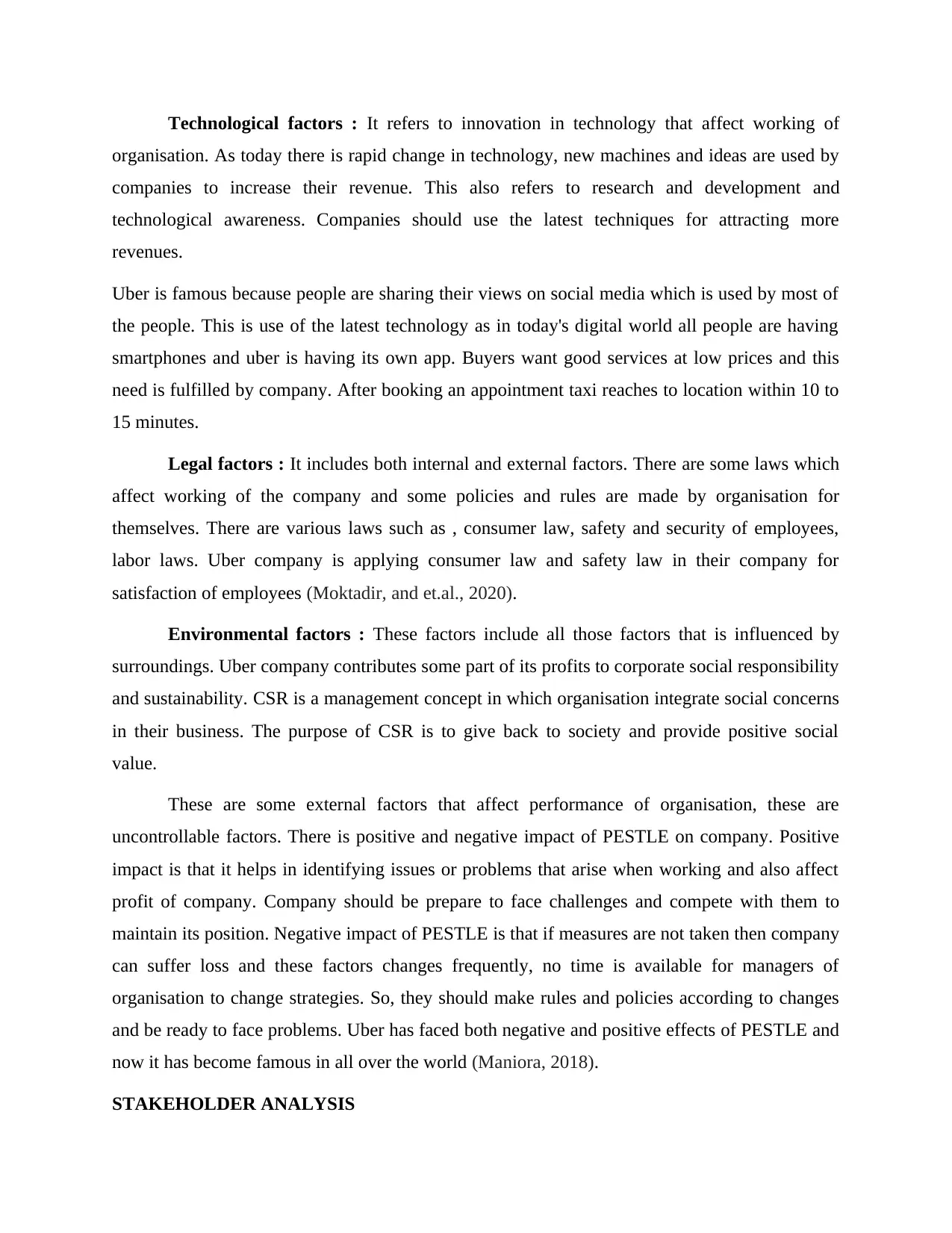
Technological factors : It refers to innovation in technology that affect working of
organisation. As today there is rapid change in technology, new machines and ideas are used by
companies to increase their revenue. This also refers to research and development and
technological awareness. Companies should use the latest techniques for attracting more
revenues.
Uber is famous because people are sharing their views on social media which is used by most of
the people. This is use of the latest technology as in today's digital world all people are having
smartphones and uber is having its own app. Buyers want good services at low prices and this
need is fulfilled by company. After booking an appointment taxi reaches to location within 10 to
15 minutes.
Legal factors : It includes both internal and external factors. There are some laws which
affect working of the company and some policies and rules are made by organisation for
themselves. There are various laws such as , consumer law, safety and security of employees,
labor laws. Uber company is applying consumer law and safety law in their company for
satisfaction of employees (Moktadir, and et.al., 2020).
Environmental factors : These factors include all those factors that is influenced by
surroundings. Uber company contributes some part of its profits to corporate social responsibility
and sustainability. CSR is a management concept in which organisation integrate social concerns
in their business. The purpose of CSR is to give back to society and provide positive social
value.
These are some external factors that affect performance of organisation, these are
uncontrollable factors. There is positive and negative impact of PESTLE on company. Positive
impact is that it helps in identifying issues or problems that arise when working and also affect
profit of company. Company should be prepare to face challenges and compete with them to
maintain its position. Negative impact of PESTLE is that if measures are not taken then company
can suffer loss and these factors changes frequently, no time is available for managers of
organisation to change strategies. So, they should make rules and policies according to changes
and be ready to face problems. Uber has faced both negative and positive effects of PESTLE and
now it has become famous in all over the world (Maniora, 2018).
STAKEHOLDER ANALYSIS
organisation. As today there is rapid change in technology, new machines and ideas are used by
companies to increase their revenue. This also refers to research and development and
technological awareness. Companies should use the latest techniques for attracting more
revenues.
Uber is famous because people are sharing their views on social media which is used by most of
the people. This is use of the latest technology as in today's digital world all people are having
smartphones and uber is having its own app. Buyers want good services at low prices and this
need is fulfilled by company. After booking an appointment taxi reaches to location within 10 to
15 minutes.
Legal factors : It includes both internal and external factors. There are some laws which
affect working of the company and some policies and rules are made by organisation for
themselves. There are various laws such as , consumer law, safety and security of employees,
labor laws. Uber company is applying consumer law and safety law in their company for
satisfaction of employees (Moktadir, and et.al., 2020).
Environmental factors : These factors include all those factors that is influenced by
surroundings. Uber company contributes some part of its profits to corporate social responsibility
and sustainability. CSR is a management concept in which organisation integrate social concerns
in their business. The purpose of CSR is to give back to society and provide positive social
value.
These are some external factors that affect performance of organisation, these are
uncontrollable factors. There is positive and negative impact of PESTLE on company. Positive
impact is that it helps in identifying issues or problems that arise when working and also affect
profit of company. Company should be prepare to face challenges and compete with them to
maintain its position. Negative impact of PESTLE is that if measures are not taken then company
can suffer loss and these factors changes frequently, no time is available for managers of
organisation to change strategies. So, they should make rules and policies according to changes
and be ready to face problems. Uber has faced both negative and positive effects of PESTLE and
now it has become famous in all over the world (Maniora, 2018).
STAKEHOLDER ANALYSIS
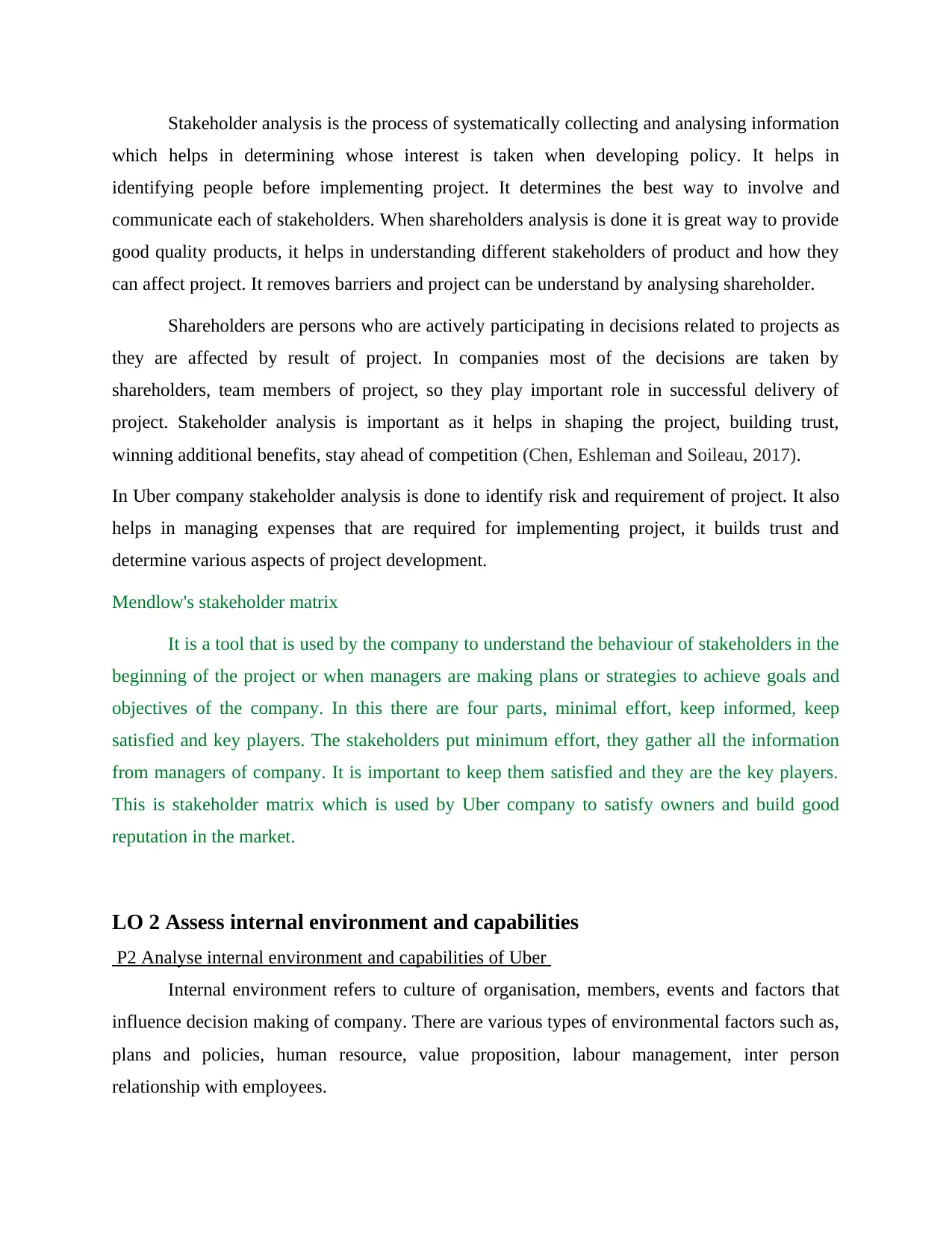
Stakeholder analysis is the process of systematically collecting and analysing information
which helps in determining whose interest is taken when developing policy. It helps in
identifying people before implementing project. It determines the best way to involve and
communicate each of stakeholders. When shareholders analysis is done it is great way to provide
good quality products, it helps in understanding different stakeholders of product and how they
can affect project. It removes barriers and project can be understand by analysing shareholder.
Shareholders are persons who are actively participating in decisions related to projects as
they are affected by result of project. In companies most of the decisions are taken by
shareholders, team members of project, so they play important role in successful delivery of
project. Stakeholder analysis is important as it helps in shaping the project, building trust,
winning additional benefits, stay ahead of competition (Chen, Eshleman and Soileau, 2017).
In Uber company stakeholder analysis is done to identify risk and requirement of project. It also
helps in managing expenses that are required for implementing project, it builds trust and
determine various aspects of project development.
Mendlow's stakeholder matrix
It is a tool that is used by the company to understand the behaviour of stakeholders in the
beginning of the project or when managers are making plans or strategies to achieve goals and
objectives of the company. In this there are four parts, minimal effort, keep informed, keep
satisfied and key players. The stakeholders put minimum effort, they gather all the information
from managers of company. It is important to keep them satisfied and they are the key players.
This is stakeholder matrix which is used by Uber company to satisfy owners and build good
reputation in the market.
LO 2 Assess internal environment and capabilities
P2 Analyse internal environment and capabilities of Uber
Internal environment refers to culture of organisation, members, events and factors that
influence decision making of company. There are various types of environmental factors such as,
plans and policies, human resource, value proposition, labour management, inter person
relationship with employees.
which helps in determining whose interest is taken when developing policy. It helps in
identifying people before implementing project. It determines the best way to involve and
communicate each of stakeholders. When shareholders analysis is done it is great way to provide
good quality products, it helps in understanding different stakeholders of product and how they
can affect project. It removes barriers and project can be understand by analysing shareholder.
Shareholders are persons who are actively participating in decisions related to projects as
they are affected by result of project. In companies most of the decisions are taken by
shareholders, team members of project, so they play important role in successful delivery of
project. Stakeholder analysis is important as it helps in shaping the project, building trust,
winning additional benefits, stay ahead of competition (Chen, Eshleman and Soileau, 2017).
In Uber company stakeholder analysis is done to identify risk and requirement of project. It also
helps in managing expenses that are required for implementing project, it builds trust and
determine various aspects of project development.
Mendlow's stakeholder matrix
It is a tool that is used by the company to understand the behaviour of stakeholders in the
beginning of the project or when managers are making plans or strategies to achieve goals and
objectives of the company. In this there are four parts, minimal effort, keep informed, keep
satisfied and key players. The stakeholders put minimum effort, they gather all the information
from managers of company. It is important to keep them satisfied and they are the key players.
This is stakeholder matrix which is used by Uber company to satisfy owners and build good
reputation in the market.
LO 2 Assess internal environment and capabilities
P2 Analyse internal environment and capabilities of Uber
Internal environment refers to culture of organisation, members, events and factors that
influence decision making of company. There are various types of environmental factors such as,
plans and policies, human resource, value proposition, labour management, inter person
relationship with employees.
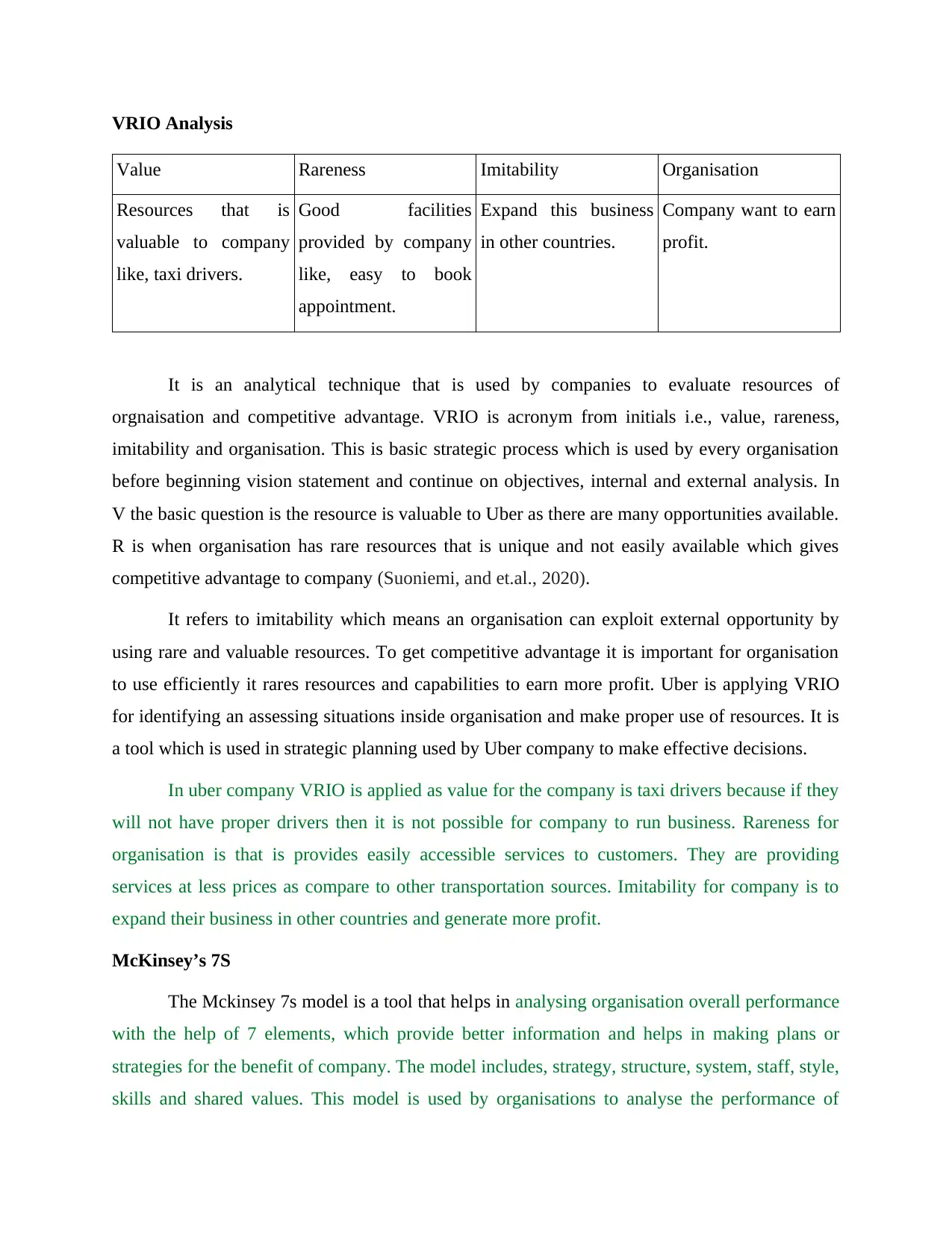
VRIO Analysis
Value Rareness Imitability Organisation
Resources that is
valuable to company
like, taxi drivers.
Good facilities
provided by company
like, easy to book
appointment.
Expand this business
in other countries.
Company want to earn
profit.
It is an analytical technique that is used by companies to evaluate resources of
orgnaisation and competitive advantage. VRIO is acronym from initials i.e., value, rareness,
imitability and organisation. This is basic strategic process which is used by every organisation
before beginning vision statement and continue on objectives, internal and external analysis. In
V the basic question is the resource is valuable to Uber as there are many opportunities available.
R is when organisation has rare resources that is unique and not easily available which gives
competitive advantage to company (Suoniemi, and et.al., 2020).
It refers to imitability which means an organisation can exploit external opportunity by
using rare and valuable resources. To get competitive advantage it is important for organisation
to use efficiently it rares resources and capabilities to earn more profit. Uber is applying VRIO
for identifying an assessing situations inside organisation and make proper use of resources. It is
a tool which is used in strategic planning used by Uber company to make effective decisions.
In uber company VRIO is applied as value for the company is taxi drivers because if they
will not have proper drivers then it is not possible for company to run business. Rareness for
organisation is that is provides easily accessible services to customers. They are providing
services at less prices as compare to other transportation sources. Imitability for company is to
expand their business in other countries and generate more profit.
McKinsey’s 7S
The Mckinsey 7s model is a tool that helps in analysing organisation overall performance
with the help of 7 elements, which provide better information and helps in making plans or
strategies for the benefit of company. The model includes, strategy, structure, system, staff, style,
skills and shared values. This model is used by organisations to analyse the performance of
Value Rareness Imitability Organisation
Resources that is
valuable to company
like, taxi drivers.
Good facilities
provided by company
like, easy to book
appointment.
Expand this business
in other countries.
Company want to earn
profit.
It is an analytical technique that is used by companies to evaluate resources of
orgnaisation and competitive advantage. VRIO is acronym from initials i.e., value, rareness,
imitability and organisation. This is basic strategic process which is used by every organisation
before beginning vision statement and continue on objectives, internal and external analysis. In
V the basic question is the resource is valuable to Uber as there are many opportunities available.
R is when organisation has rare resources that is unique and not easily available which gives
competitive advantage to company (Suoniemi, and et.al., 2020).
It refers to imitability which means an organisation can exploit external opportunity by
using rare and valuable resources. To get competitive advantage it is important for organisation
to use efficiently it rares resources and capabilities to earn more profit. Uber is applying VRIO
for identifying an assessing situations inside organisation and make proper use of resources. It is
a tool which is used in strategic planning used by Uber company to make effective decisions.
In uber company VRIO is applied as value for the company is taxi drivers because if they
will not have proper drivers then it is not possible for company to run business. Rareness for
organisation is that is provides easily accessible services to customers. They are providing
services at less prices as compare to other transportation sources. Imitability for company is to
expand their business in other countries and generate more profit.
McKinsey’s 7S
The Mckinsey 7s model is a tool that helps in analysing organisation overall performance
with the help of 7 elements, which provide better information and helps in making plans or
strategies for the benefit of company. The model includes, strategy, structure, system, staff, style,
skills and shared values. This model is used by organisations to analyse the performance of
Paraphrase This Document
Need a fresh take? Get an instant paraphrase of this document with our AI Paraphraser
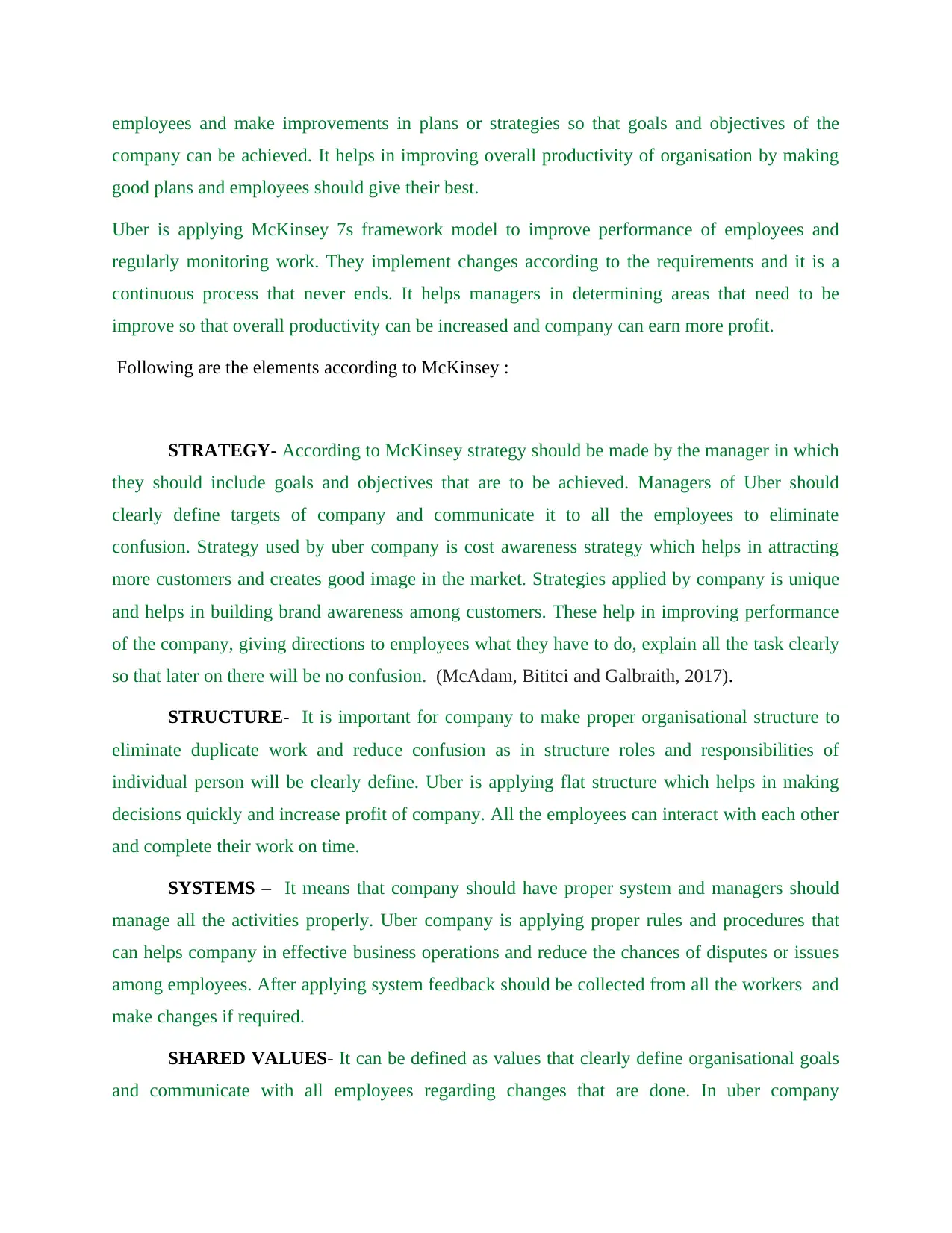
employees and make improvements in plans or strategies so that goals and objectives of the
company can be achieved. It helps in improving overall productivity of organisation by making
good plans and employees should give their best.
Uber is applying McKinsey 7s framework model to improve performance of employees and
regularly monitoring work. They implement changes according to the requirements and it is a
continuous process that never ends. It helps managers in determining areas that need to be
improve so that overall productivity can be increased and company can earn more profit.
Following are the elements according to McKinsey :
STRATEGY- According to McKinsey strategy should be made by the manager in which
they should include goals and objectives that are to be achieved. Managers of Uber should
clearly define targets of company and communicate it to all the employees to eliminate
confusion. Strategy used by uber company is cost awareness strategy which helps in attracting
more customers and creates good image in the market. Strategies applied by company is unique
and helps in building brand awareness among customers. These help in improving performance
of the company, giving directions to employees what they have to do, explain all the task clearly
so that later on there will be no confusion. (McAdam, Bititci and Galbraith, 2017).
STRUCTURE- It is important for company to make proper organisational structure to
eliminate duplicate work and reduce confusion as in structure roles and responsibilities of
individual person will be clearly define. Uber is applying flat structure which helps in making
decisions quickly and increase profit of company. All the employees can interact with each other
and complete their work on time.
SYSTEMS – It means that company should have proper system and managers should
manage all the activities properly. Uber company is applying proper rules and procedures that
can helps company in effective business operations and reduce the chances of disputes or issues
among employees. After applying system feedback should be collected from all the workers and
make changes if required.
SHARED VALUES- It can be defined as values that clearly define organisational goals
and communicate with all employees regarding changes that are done. In uber company
company can be achieved. It helps in improving overall productivity of organisation by making
good plans and employees should give their best.
Uber is applying McKinsey 7s framework model to improve performance of employees and
regularly monitoring work. They implement changes according to the requirements and it is a
continuous process that never ends. It helps managers in determining areas that need to be
improve so that overall productivity can be increased and company can earn more profit.
Following are the elements according to McKinsey :
STRATEGY- According to McKinsey strategy should be made by the manager in which
they should include goals and objectives that are to be achieved. Managers of Uber should
clearly define targets of company and communicate it to all the employees to eliminate
confusion. Strategy used by uber company is cost awareness strategy which helps in attracting
more customers and creates good image in the market. Strategies applied by company is unique
and helps in building brand awareness among customers. These help in improving performance
of the company, giving directions to employees what they have to do, explain all the task clearly
so that later on there will be no confusion. (McAdam, Bititci and Galbraith, 2017).
STRUCTURE- It is important for company to make proper organisational structure to
eliminate duplicate work and reduce confusion as in structure roles and responsibilities of
individual person will be clearly define. Uber is applying flat structure which helps in making
decisions quickly and increase profit of company. All the employees can interact with each other
and complete their work on time.
SYSTEMS – It means that company should have proper system and managers should
manage all the activities properly. Uber company is applying proper rules and procedures that
can helps company in effective business operations and reduce the chances of disputes or issues
among employees. After applying system feedback should be collected from all the workers and
make changes if required.
SHARED VALUES- It can be defined as values that clearly define organisational goals
and communicate with all employees regarding changes that are done. In uber company
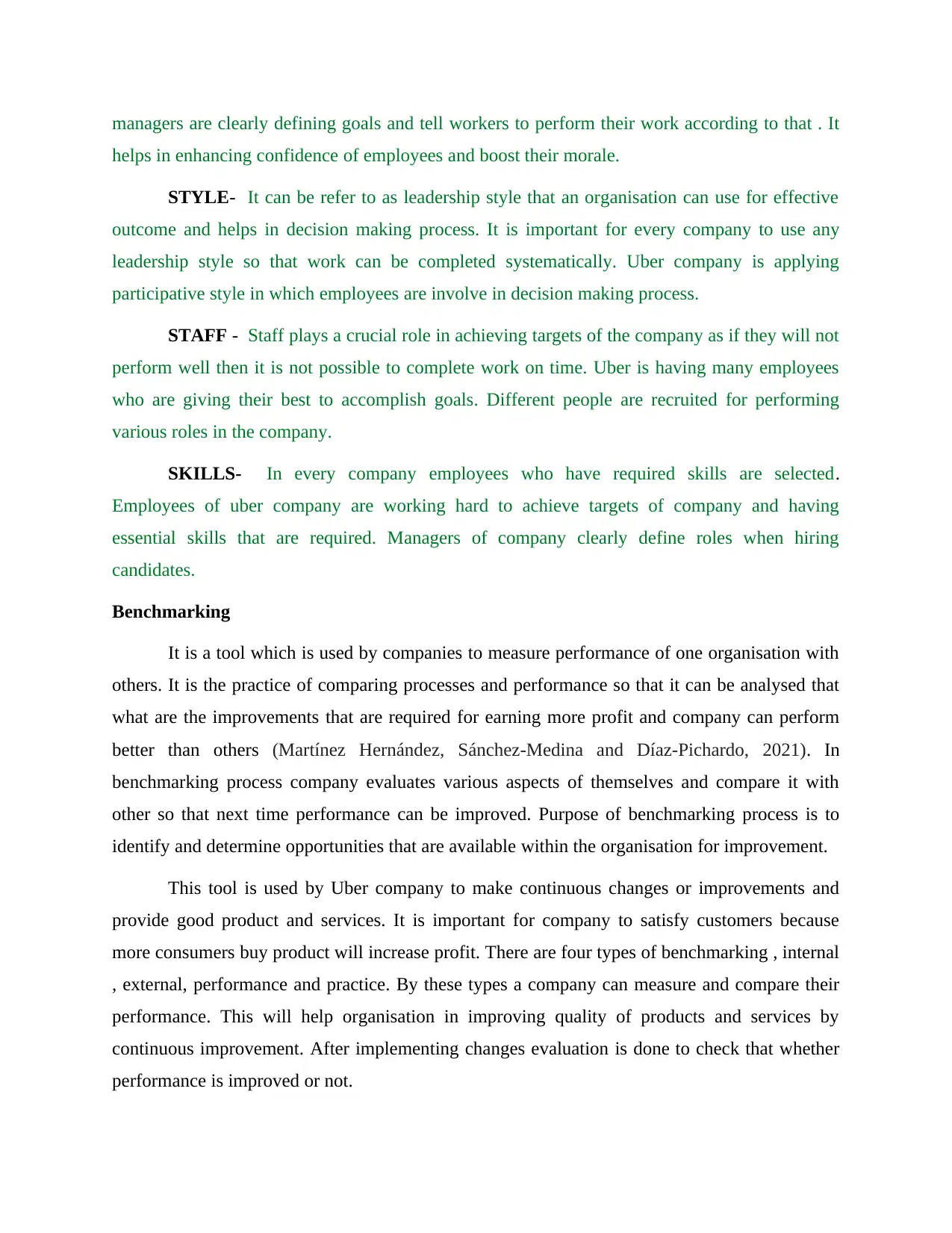
managers are clearly defining goals and tell workers to perform their work according to that . It
helps in enhancing confidence of employees and boost their morale.
STYLE- It can be refer to as leadership style that an organisation can use for effective
outcome and helps in decision making process. It is important for every company to use any
leadership style so that work can be completed systematically. Uber company is applying
participative style in which employees are involve in decision making process.
STAFF - Staff plays a crucial role in achieving targets of the company as if they will not
perform well then it is not possible to complete work on time. Uber is having many employees
who are giving their best to accomplish goals. Different people are recruited for performing
various roles in the company.
SKILLS- In every company employees who have required skills are selected.
Employees of uber company are working hard to achieve targets of company and having
essential skills that are required. Managers of company clearly define roles when hiring
candidates.
Benchmarking
It is a tool which is used by companies to measure performance of one organisation with
others. It is the practice of comparing processes and performance so that it can be analysed that
what are the improvements that are required for earning more profit and company can perform
better than others (Martínez Hernández, Sánchez‐Medina and Díaz‐Pichardo, 2021). In
benchmarking process company evaluates various aspects of themselves and compare it with
other so that next time performance can be improved. Purpose of benchmarking process is to
identify and determine opportunities that are available within the organisation for improvement.
This tool is used by Uber company to make continuous changes or improvements and
provide good product and services. It is important for company to satisfy customers because
more consumers buy product will increase profit. There are four types of benchmarking , internal
, external, performance and practice. By these types a company can measure and compare their
performance. This will help organisation in improving quality of products and services by
continuous improvement. After implementing changes evaluation is done to check that whether
performance is improved or not.
helps in enhancing confidence of employees and boost their morale.
STYLE- It can be refer to as leadership style that an organisation can use for effective
outcome and helps in decision making process. It is important for every company to use any
leadership style so that work can be completed systematically. Uber company is applying
participative style in which employees are involve in decision making process.
STAFF - Staff plays a crucial role in achieving targets of the company as if they will not
perform well then it is not possible to complete work on time. Uber is having many employees
who are giving their best to accomplish goals. Different people are recruited for performing
various roles in the company.
SKILLS- In every company employees who have required skills are selected.
Employees of uber company are working hard to achieve targets of company and having
essential skills that are required. Managers of company clearly define roles when hiring
candidates.
Benchmarking
It is a tool which is used by companies to measure performance of one organisation with
others. It is the practice of comparing processes and performance so that it can be analysed that
what are the improvements that are required for earning more profit and company can perform
better than others (Martínez Hernández, Sánchez‐Medina and Díaz‐Pichardo, 2021). In
benchmarking process company evaluates various aspects of themselves and compare it with
other so that next time performance can be improved. Purpose of benchmarking process is to
identify and determine opportunities that are available within the organisation for improvement.
This tool is used by Uber company to make continuous changes or improvements and
provide good product and services. It is important for company to satisfy customers because
more consumers buy product will increase profit. There are four types of benchmarking , internal
, external, performance and practice. By these types a company can measure and compare their
performance. This will help organisation in improving quality of products and services by
continuous improvement. After implementing changes evaluation is done to check that whether
performance is improved or not.
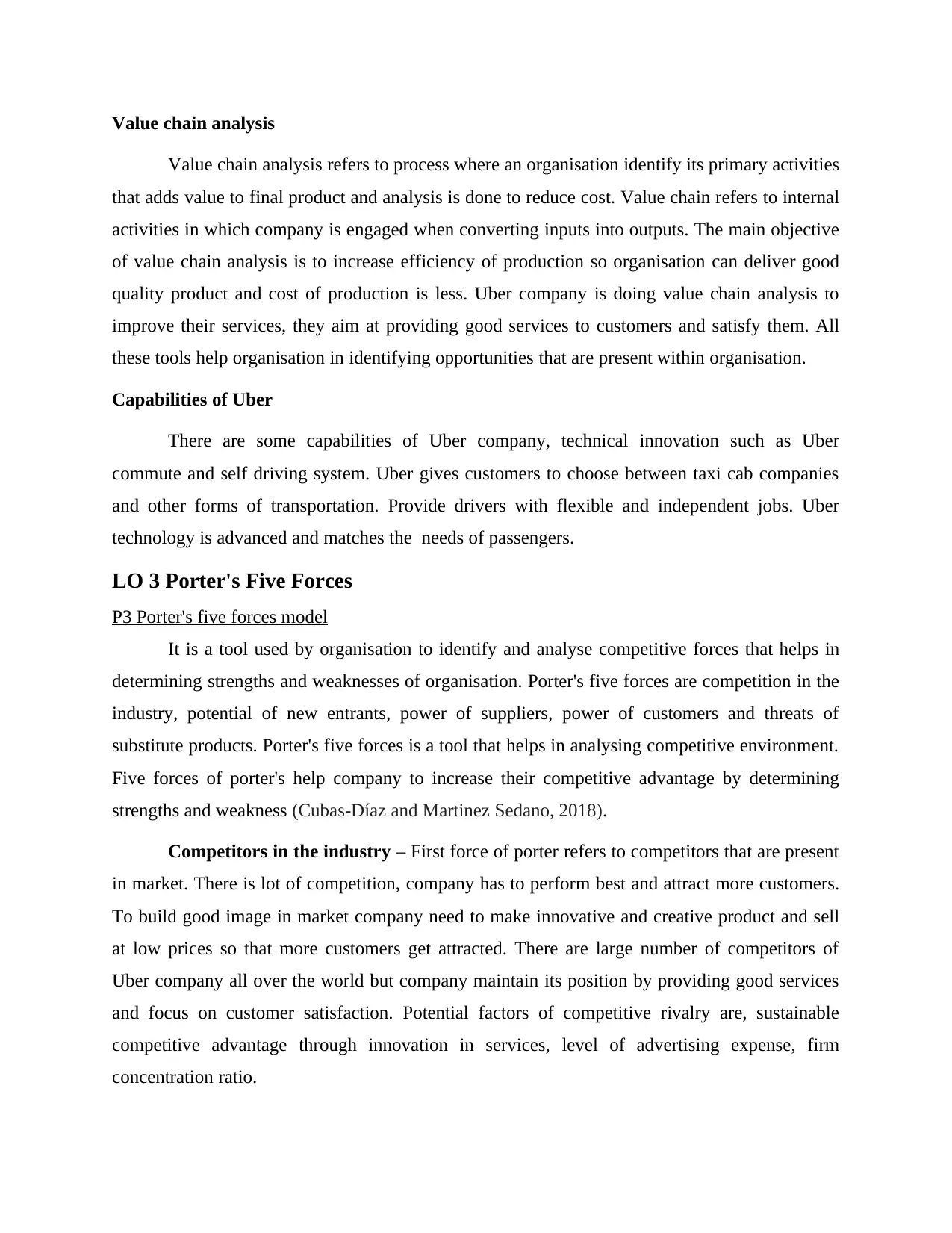
Value chain analysis
Value chain analysis refers to process where an organisation identify its primary activities
that adds value to final product and analysis is done to reduce cost. Value chain refers to internal
activities in which company is engaged when converting inputs into outputs. The main objective
of value chain analysis is to increase efficiency of production so organisation can deliver good
quality product and cost of production is less. Uber company is doing value chain analysis to
improve their services, they aim at providing good services to customers and satisfy them. All
these tools help organisation in identifying opportunities that are present within organisation.
Capabilities of Uber
There are some capabilities of Uber company, technical innovation such as Uber
commute and self driving system. Uber gives customers to choose between taxi cab companies
and other forms of transportation. Provide drivers with flexible and independent jobs. Uber
technology is advanced and matches the needs of passengers.
LO 3 Porter's Five Forces
P3 Porter's five forces model
It is a tool used by organisation to identify and analyse competitive forces that helps in
determining strengths and weaknesses of organisation. Porter's five forces are competition in the
industry, potential of new entrants, power of suppliers, power of customers and threats of
substitute products. Porter's five forces is a tool that helps in analysing competitive environment.
Five forces of porter's help company to increase their competitive advantage by determining
strengths and weakness (Cubas‐Díaz and Martinez Sedano, 2018).
Competitors in the industry – First force of porter refers to competitors that are present
in market. There is lot of competition, company has to perform best and attract more customers.
To build good image in market company need to make innovative and creative product and sell
at low prices so that more customers get attracted. There are large number of competitors of
Uber company all over the world but company maintain its position by providing good services
and focus on customer satisfaction. Potential factors of competitive rivalry are, sustainable
competitive advantage through innovation in services, level of advertising expense, firm
concentration ratio.
Value chain analysis refers to process where an organisation identify its primary activities
that adds value to final product and analysis is done to reduce cost. Value chain refers to internal
activities in which company is engaged when converting inputs into outputs. The main objective
of value chain analysis is to increase efficiency of production so organisation can deliver good
quality product and cost of production is less. Uber company is doing value chain analysis to
improve their services, they aim at providing good services to customers and satisfy them. All
these tools help organisation in identifying opportunities that are present within organisation.
Capabilities of Uber
There are some capabilities of Uber company, technical innovation such as Uber
commute and self driving system. Uber gives customers to choose between taxi cab companies
and other forms of transportation. Provide drivers with flexible and independent jobs. Uber
technology is advanced and matches the needs of passengers.
LO 3 Porter's Five Forces
P3 Porter's five forces model
It is a tool used by organisation to identify and analyse competitive forces that helps in
determining strengths and weaknesses of organisation. Porter's five forces are competition in the
industry, potential of new entrants, power of suppliers, power of customers and threats of
substitute products. Porter's five forces is a tool that helps in analysing competitive environment.
Five forces of porter's help company to increase their competitive advantage by determining
strengths and weakness (Cubas‐Díaz and Martinez Sedano, 2018).
Competitors in the industry – First force of porter refers to competitors that are present
in market. There is lot of competition, company has to perform best and attract more customers.
To build good image in market company need to make innovative and creative product and sell
at low prices so that more customers get attracted. There are large number of competitors of
Uber company all over the world but company maintain its position by providing good services
and focus on customer satisfaction. Potential factors of competitive rivalry are, sustainable
competitive advantage through innovation in services, level of advertising expense, firm
concentration ratio.
Secure Best Marks with AI Grader
Need help grading? Try our AI Grader for instant feedback on your assignments.
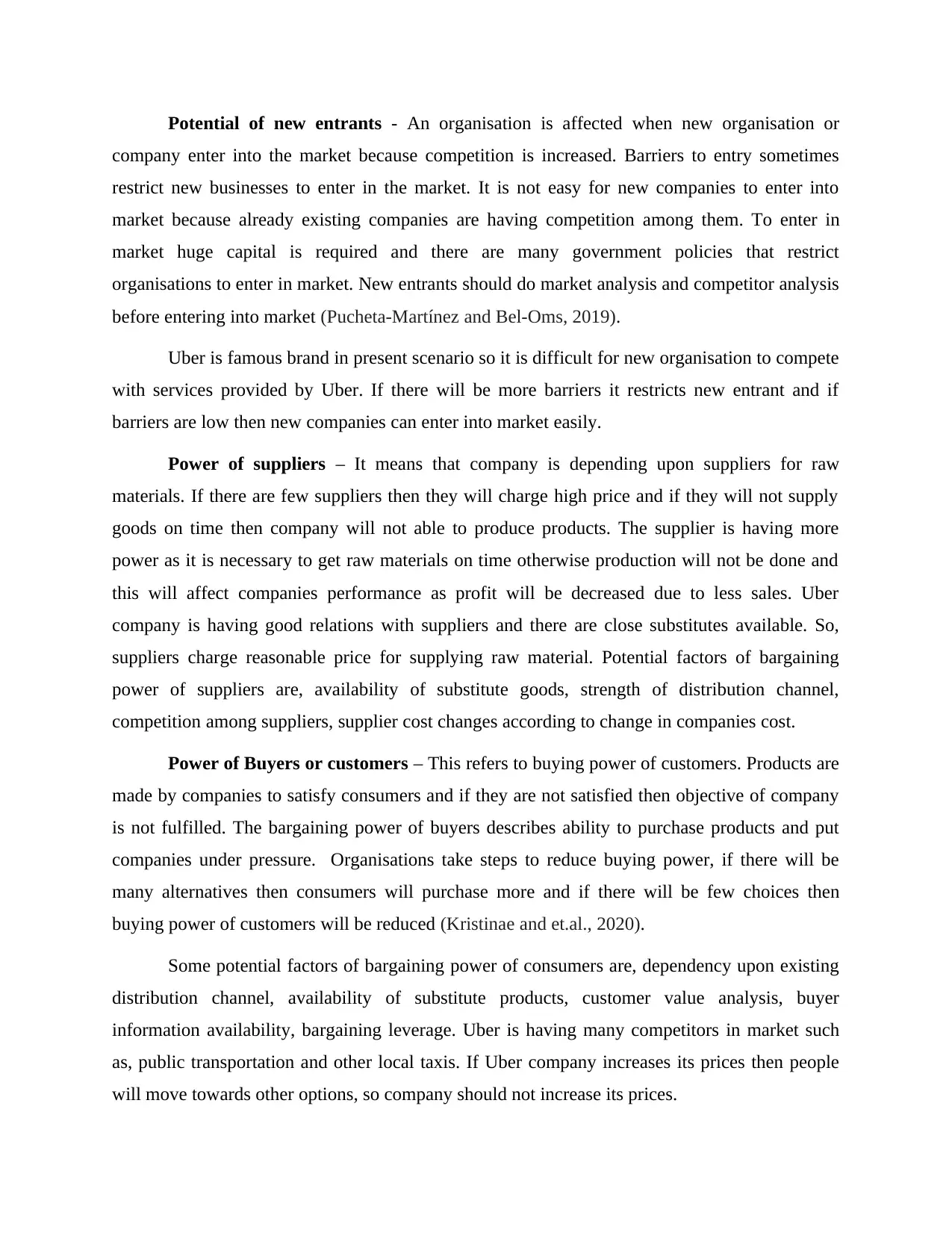
Potential of new entrants - An organisation is affected when new organisation or
company enter into the market because competition is increased. Barriers to entry sometimes
restrict new businesses to enter in the market. It is not easy for new companies to enter into
market because already existing companies are having competition among them. To enter in
market huge capital is required and there are many government policies that restrict
organisations to enter in market. New entrants should do market analysis and competitor analysis
before entering into market (Pucheta‐Martínez and Bel‐Oms, 2019).
Uber is famous brand in present scenario so it is difficult for new organisation to compete
with services provided by Uber. If there will be more barriers it restricts new entrant and if
barriers are low then new companies can enter into market easily.
Power of suppliers – It means that company is depending upon suppliers for raw
materials. If there are few suppliers then they will charge high price and if they will not supply
goods on time then company will not able to produce products. The supplier is having more
power as it is necessary to get raw materials on time otherwise production will not be done and
this will affect companies performance as profit will be decreased due to less sales. Uber
company is having good relations with suppliers and there are close substitutes available. So,
suppliers charge reasonable price for supplying raw material. Potential factors of bargaining
power of suppliers are, availability of substitute goods, strength of distribution channel,
competition among suppliers, supplier cost changes according to change in companies cost.
Power of Buyers or customers – This refers to buying power of customers. Products are
made by companies to satisfy consumers and if they are not satisfied then objective of company
is not fulfilled. The bargaining power of buyers describes ability to purchase products and put
companies under pressure. Organisations take steps to reduce buying power, if there will be
many alternatives then consumers will purchase more and if there will be few choices then
buying power of customers will be reduced (Kristinae and et.al., 2020).
Some potential factors of bargaining power of consumers are, dependency upon existing
distribution channel, availability of substitute products, customer value analysis, buyer
information availability, bargaining leverage. Uber is having many competitors in market such
as, public transportation and other local taxis. If Uber company increases its prices then people
will move towards other options, so company should not increase its prices.
company enter into the market because competition is increased. Barriers to entry sometimes
restrict new businesses to enter in the market. It is not easy for new companies to enter into
market because already existing companies are having competition among them. To enter in
market huge capital is required and there are many government policies that restrict
organisations to enter in market. New entrants should do market analysis and competitor analysis
before entering into market (Pucheta‐Martínez and Bel‐Oms, 2019).
Uber is famous brand in present scenario so it is difficult for new organisation to compete
with services provided by Uber. If there will be more barriers it restricts new entrant and if
barriers are low then new companies can enter into market easily.
Power of suppliers – It means that company is depending upon suppliers for raw
materials. If there are few suppliers then they will charge high price and if they will not supply
goods on time then company will not able to produce products. The supplier is having more
power as it is necessary to get raw materials on time otherwise production will not be done and
this will affect companies performance as profit will be decreased due to less sales. Uber
company is having good relations with suppliers and there are close substitutes available. So,
suppliers charge reasonable price for supplying raw material. Potential factors of bargaining
power of suppliers are, availability of substitute goods, strength of distribution channel,
competition among suppliers, supplier cost changes according to change in companies cost.
Power of Buyers or customers – This refers to buying power of customers. Products are
made by companies to satisfy consumers and if they are not satisfied then objective of company
is not fulfilled. The bargaining power of buyers describes ability to purchase products and put
companies under pressure. Organisations take steps to reduce buying power, if there will be
many alternatives then consumers will purchase more and if there will be few choices then
buying power of customers will be reduced (Kristinae and et.al., 2020).
Some potential factors of bargaining power of consumers are, dependency upon existing
distribution channel, availability of substitute products, customer value analysis, buyer
information availability, bargaining leverage. Uber is having many competitors in market such
as, public transportation and other local taxis. If Uber company increases its prices then people
will move towards other options, so company should not increase its prices.
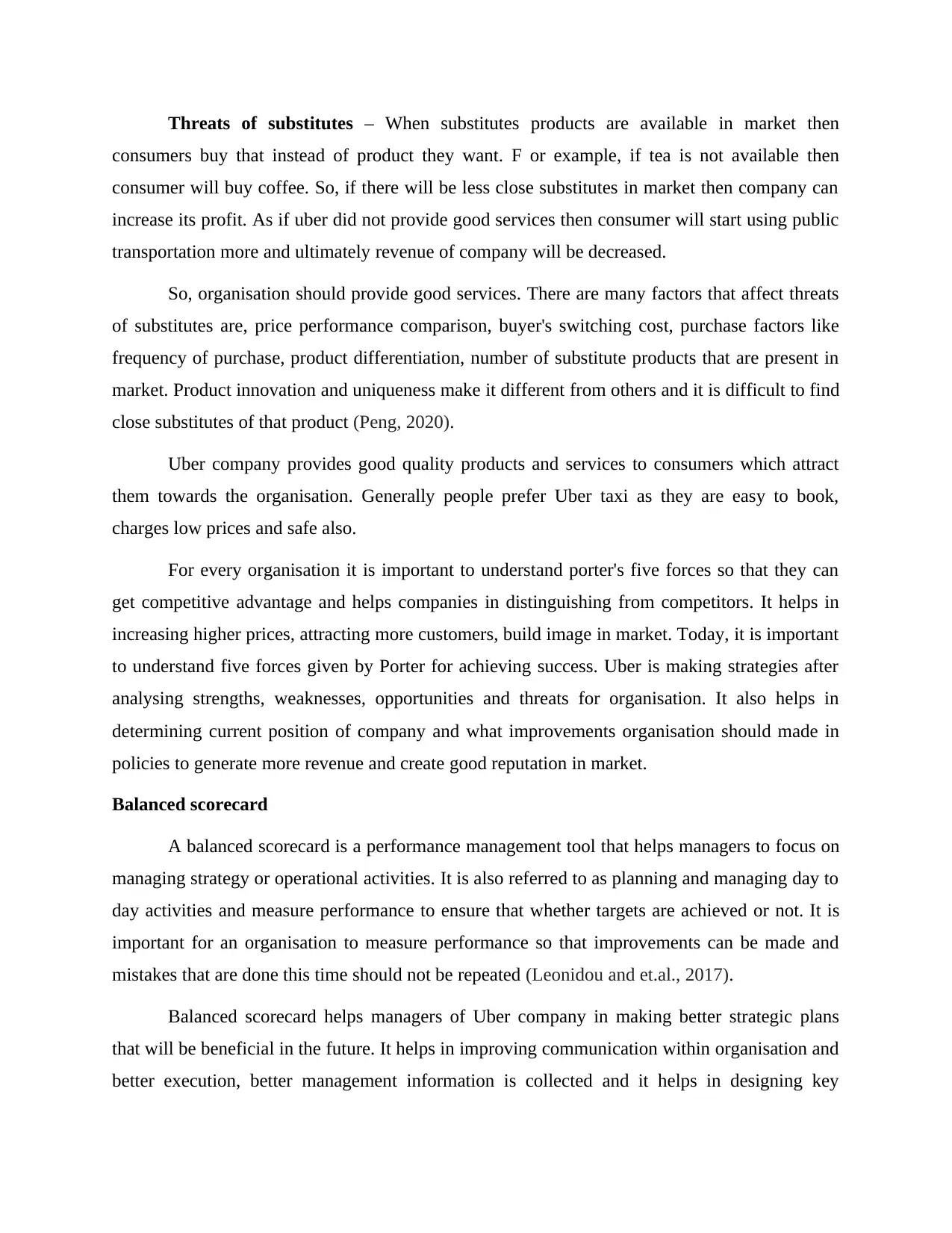
Threats of substitutes – When substitutes products are available in market then
consumers buy that instead of product they want. F or example, if tea is not available then
consumer will buy coffee. So, if there will be less close substitutes in market then company can
increase its profit. As if uber did not provide good services then consumer will start using public
transportation more and ultimately revenue of company will be decreased.
So, organisation should provide good services. There are many factors that affect threats
of substitutes are, price performance comparison, buyer's switching cost, purchase factors like
frequency of purchase, product differentiation, number of substitute products that are present in
market. Product innovation and uniqueness make it different from others and it is difficult to find
close substitutes of that product (Peng, 2020).
Uber company provides good quality products and services to consumers which attract
them towards the organisation. Generally people prefer Uber taxi as they are easy to book,
charges low prices and safe also.
For every organisation it is important to understand porter's five forces so that they can
get competitive advantage and helps companies in distinguishing from competitors. It helps in
increasing higher prices, attracting more customers, build image in market. Today, it is important
to understand five forces given by Porter for achieving success. Uber is making strategies after
analysing strengths, weaknesses, opportunities and threats for organisation. It also helps in
determining current position of company and what improvements organisation should made in
policies to generate more revenue and create good reputation in market.
Balanced scorecard
A balanced scorecard is a performance management tool that helps managers to focus on
managing strategy or operational activities. It is also referred to as planning and managing day to
day activities and measure performance to ensure that whether targets are achieved or not. It is
important for an organisation to measure performance so that improvements can be made and
mistakes that are done this time should not be repeated (Leonidou and et.al., 2017).
Balanced scorecard helps managers of Uber company in making better strategic plans
that will be beneficial in the future. It helps in improving communication within organisation and
better execution, better management information is collected and it helps in designing key
consumers buy that instead of product they want. F or example, if tea is not available then
consumer will buy coffee. So, if there will be less close substitutes in market then company can
increase its profit. As if uber did not provide good services then consumer will start using public
transportation more and ultimately revenue of company will be decreased.
So, organisation should provide good services. There are many factors that affect threats
of substitutes are, price performance comparison, buyer's switching cost, purchase factors like
frequency of purchase, product differentiation, number of substitute products that are present in
market. Product innovation and uniqueness make it different from others and it is difficult to find
close substitutes of that product (Peng, 2020).
Uber company provides good quality products and services to consumers which attract
them towards the organisation. Generally people prefer Uber taxi as they are easy to book,
charges low prices and safe also.
For every organisation it is important to understand porter's five forces so that they can
get competitive advantage and helps companies in distinguishing from competitors. It helps in
increasing higher prices, attracting more customers, build image in market. Today, it is important
to understand five forces given by Porter for achieving success. Uber is making strategies after
analysing strengths, weaknesses, opportunities and threats for organisation. It also helps in
determining current position of company and what improvements organisation should made in
policies to generate more revenue and create good reputation in market.
Balanced scorecard
A balanced scorecard is a performance management tool that helps managers to focus on
managing strategy or operational activities. It is also referred to as planning and managing day to
day activities and measure performance to ensure that whether targets are achieved or not. It is
important for an organisation to measure performance so that improvements can be made and
mistakes that are done this time should not be repeated (Leonidou and et.al., 2017).
Balanced scorecard helps managers of Uber company in making better strategic plans
that will be beneficial in the future. It helps in improving communication within organisation and
better execution, better management information is collected and it helps in designing key
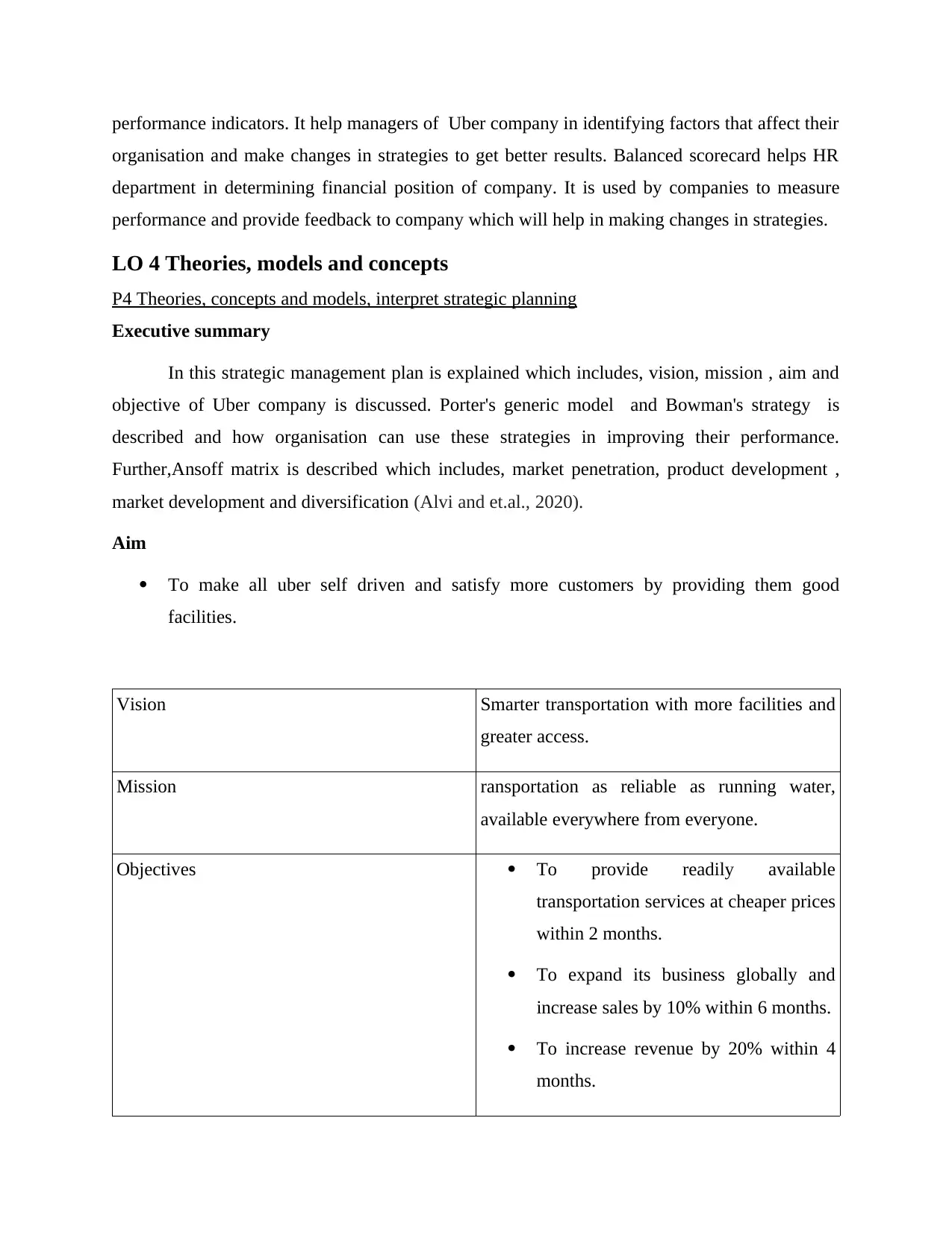
performance indicators. It help managers of Uber company in identifying factors that affect their
organisation and make changes in strategies to get better results. Balanced scorecard helps HR
department in determining financial position of company. It is used by companies to measure
performance and provide feedback to company which will help in making changes in strategies.
LO 4 Theories, models and concepts
P4 Theories, concepts and models, interpret strategic planning
Executive summary
In this strategic management plan is explained which includes, vision, mission , aim and
objective of Uber company is discussed. Porter's generic model and Bowman's strategy is
described and how organisation can use these strategies in improving their performance.
Further,Ansoff matrix is described which includes, market penetration, product development ,
market development and diversification (Alvi and et.al., 2020).
Aim
To make all uber self driven and satisfy more customers by providing them good
facilities.
Vision Smarter transportation with more facilities and
greater access.
Mission ransportation as reliable as running water,
available everywhere from everyone.
Objectives To provide readily available
transportation services at cheaper prices
within 2 months.
To expand its business globally and
increase sales by 10% within 6 months.
To increase revenue by 20% within 4
months.
organisation and make changes in strategies to get better results. Balanced scorecard helps HR
department in determining financial position of company. It is used by companies to measure
performance and provide feedback to company which will help in making changes in strategies.
LO 4 Theories, models and concepts
P4 Theories, concepts and models, interpret strategic planning
Executive summary
In this strategic management plan is explained which includes, vision, mission , aim and
objective of Uber company is discussed. Porter's generic model and Bowman's strategy is
described and how organisation can use these strategies in improving their performance.
Further,Ansoff matrix is described which includes, market penetration, product development ,
market development and diversification (Alvi and et.al., 2020).
Aim
To make all uber self driven and satisfy more customers by providing them good
facilities.
Vision Smarter transportation with more facilities and
greater access.
Mission ransportation as reliable as running water,
available everywhere from everyone.
Objectives To provide readily available
transportation services at cheaper prices
within 2 months.
To expand its business globally and
increase sales by 10% within 6 months.
To increase revenue by 20% within 4
months.
Paraphrase This Document
Need a fresh take? Get an instant paraphrase of this document with our AI Paraphraser
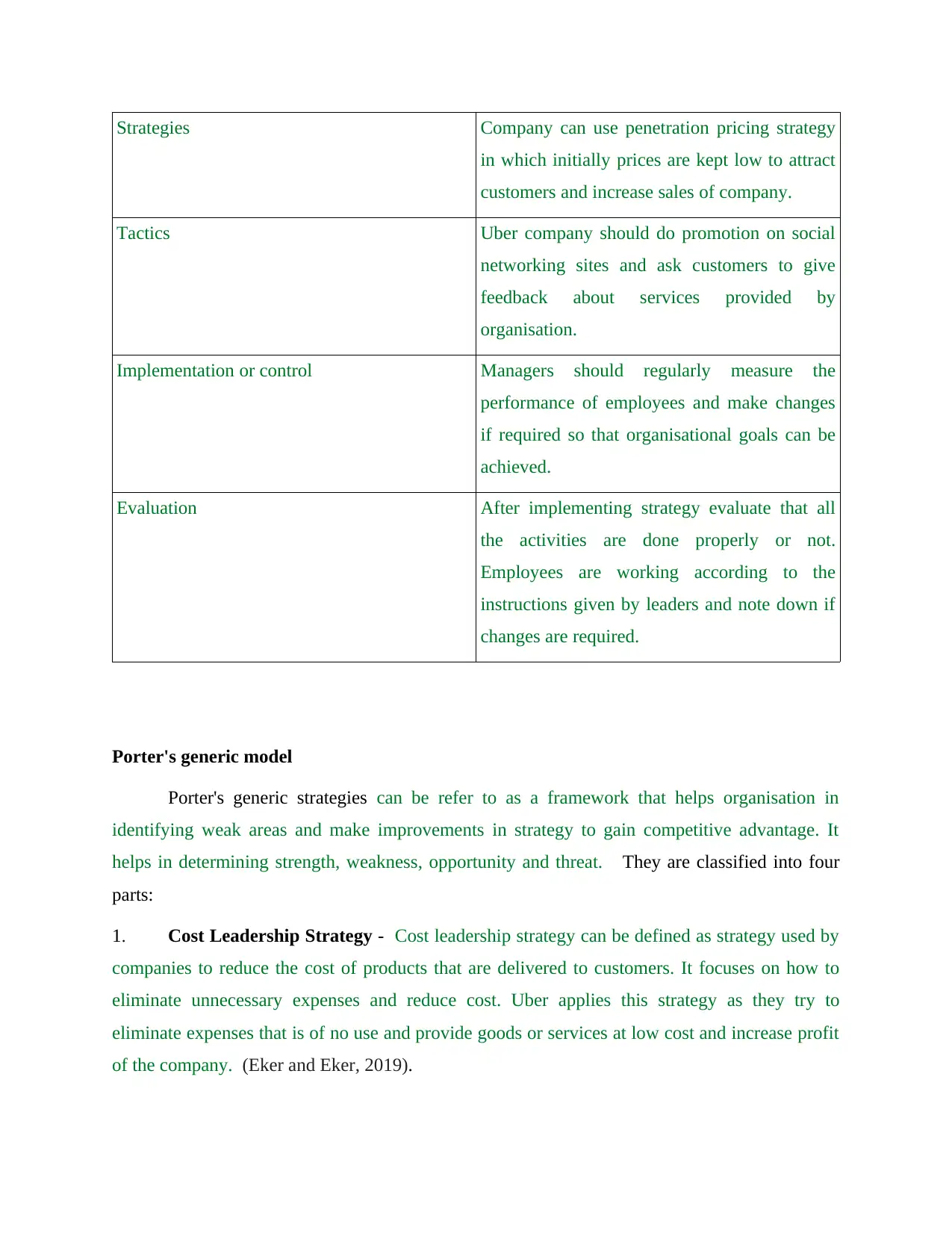
Strategies Company can use penetration pricing strategy
in which initially prices are kept low to attract
customers and increase sales of company.
Tactics Uber company should do promotion on social
networking sites and ask customers to give
feedback about services provided by
organisation.
Implementation or control Managers should regularly measure the
performance of employees and make changes
if required so that organisational goals can be
achieved.
Evaluation After implementing strategy evaluate that all
the activities are done properly or not.
Employees are working according to the
instructions given by leaders and note down if
changes are required.
Porter's generic model
Porter's generic strategies can be refer to as a framework that helps organisation in
identifying weak areas and make improvements in strategy to gain competitive advantage. It
helps in determining strength, weakness, opportunity and threat. They are classified into four
parts:
1. Cost Leadership Strategy - Cost leadership strategy can be defined as strategy used by
companies to reduce the cost of products that are delivered to customers. It focuses on how to
eliminate unnecessary expenses and reduce cost. Uber applies this strategy as they try to
eliminate expenses that is of no use and provide goods or services at low cost and increase profit
of the company. (Eker and Eker, 2019).
in which initially prices are kept low to attract
customers and increase sales of company.
Tactics Uber company should do promotion on social
networking sites and ask customers to give
feedback about services provided by
organisation.
Implementation or control Managers should regularly measure the
performance of employees and make changes
if required so that organisational goals can be
achieved.
Evaluation After implementing strategy evaluate that all
the activities are done properly or not.
Employees are working according to the
instructions given by leaders and note down if
changes are required.
Porter's generic model
Porter's generic strategies can be refer to as a framework that helps organisation in
identifying weak areas and make improvements in strategy to gain competitive advantage. It
helps in determining strength, weakness, opportunity and threat. They are classified into four
parts:
1. Cost Leadership Strategy - Cost leadership strategy can be defined as strategy used by
companies to reduce the cost of products that are delivered to customers. It focuses on how to
eliminate unnecessary expenses and reduce cost. Uber applies this strategy as they try to
eliminate expenses that is of no use and provide goods or services at low cost and increase profit
of the company. (Eker and Eker, 2019).
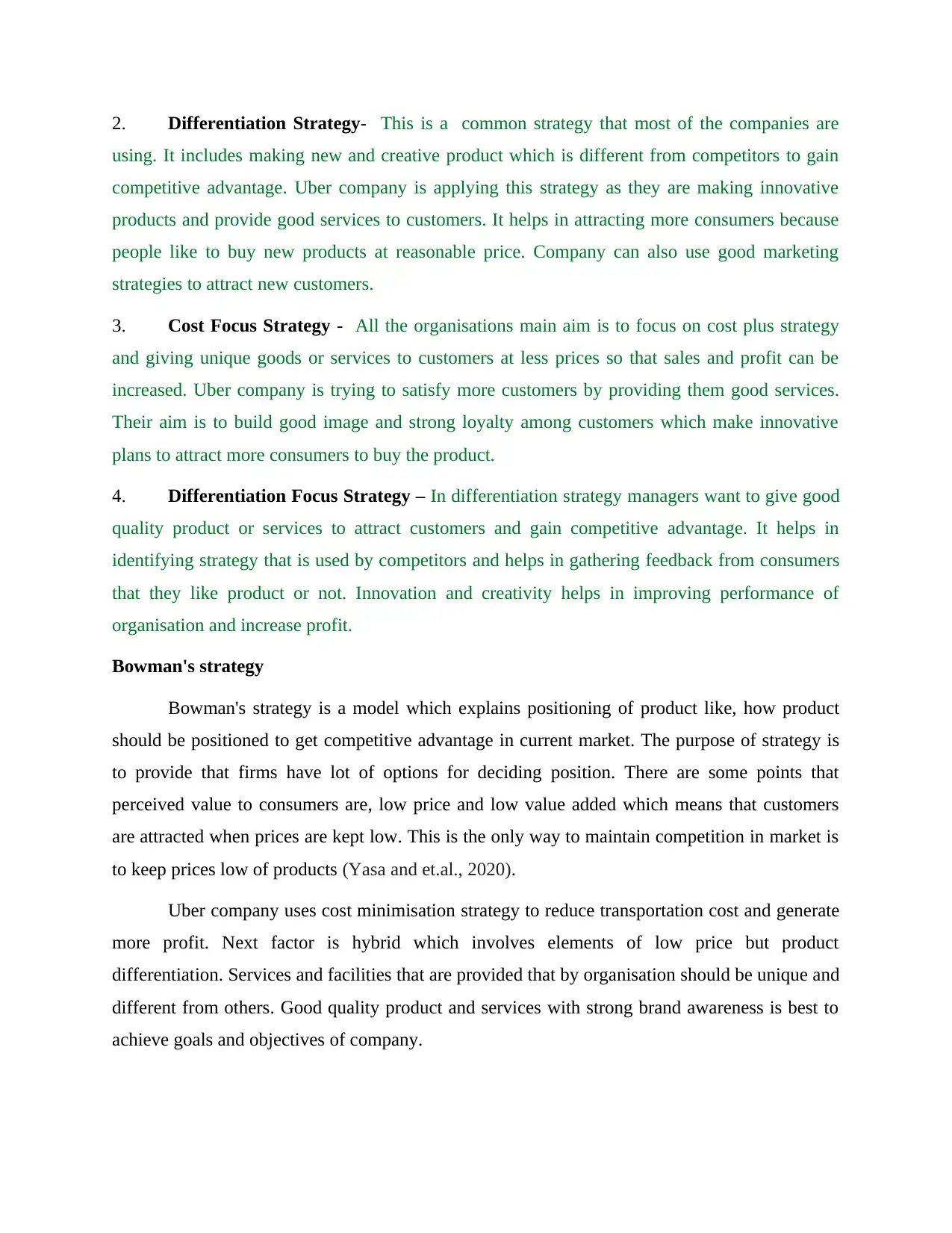
2. Differentiation Strategy- This is a common strategy that most of the companies are
using. It includes making new and creative product which is different from competitors to gain
competitive advantage. Uber company is applying this strategy as they are making innovative
products and provide good services to customers. It helps in attracting more consumers because
people like to buy new products at reasonable price. Company can also use good marketing
strategies to attract new customers.
3. Cost Focus Strategy - All the organisations main aim is to focus on cost plus strategy
and giving unique goods or services to customers at less prices so that sales and profit can be
increased. Uber company is trying to satisfy more customers by providing them good services.
Their aim is to build good image and strong loyalty among customers which make innovative
plans to attract more consumers to buy the product.
4. Differentiation Focus Strategy – In differentiation strategy managers want to give good
quality product or services to attract customers and gain competitive advantage. It helps in
identifying strategy that is used by competitors and helps in gathering feedback from consumers
that they like product or not. Innovation and creativity helps in improving performance of
organisation and increase profit.
Bowman's strategy
Bowman's strategy is a model which explains positioning of product like, how product
should be positioned to get competitive advantage in current market. The purpose of strategy is
to provide that firms have lot of options for deciding position. There are some points that
perceived value to consumers are, low price and low value added which means that customers
are attracted when prices are kept low. This is the only way to maintain competition in market is
to keep prices low of products (Yasa and et.al., 2020).
Uber company uses cost minimisation strategy to reduce transportation cost and generate
more profit. Next factor is hybrid which involves elements of low price but product
differentiation. Services and facilities that are provided that by organisation should be unique and
different from others. Good quality product and services with strong brand awareness is best to
achieve goals and objectives of company.
using. It includes making new and creative product which is different from competitors to gain
competitive advantage. Uber company is applying this strategy as they are making innovative
products and provide good services to customers. It helps in attracting more consumers because
people like to buy new products at reasonable price. Company can also use good marketing
strategies to attract new customers.
3. Cost Focus Strategy - All the organisations main aim is to focus on cost plus strategy
and giving unique goods or services to customers at less prices so that sales and profit can be
increased. Uber company is trying to satisfy more customers by providing them good services.
Their aim is to build good image and strong loyalty among customers which make innovative
plans to attract more consumers to buy the product.
4. Differentiation Focus Strategy – In differentiation strategy managers want to give good
quality product or services to attract customers and gain competitive advantage. It helps in
identifying strategy that is used by competitors and helps in gathering feedback from consumers
that they like product or not. Innovation and creativity helps in improving performance of
organisation and increase profit.
Bowman's strategy
Bowman's strategy is a model which explains positioning of product like, how product
should be positioned to get competitive advantage in current market. The purpose of strategy is
to provide that firms have lot of options for deciding position. There are some points that
perceived value to consumers are, low price and low value added which means that customers
are attracted when prices are kept low. This is the only way to maintain competition in market is
to keep prices low of products (Yasa and et.al., 2020).
Uber company uses cost minimisation strategy to reduce transportation cost and generate
more profit. Next factor is hybrid which involves elements of low price but product
differentiation. Services and facilities that are provided that by organisation should be unique and
different from others. Good quality product and services with strong brand awareness is best to
achieve goals and objectives of company.
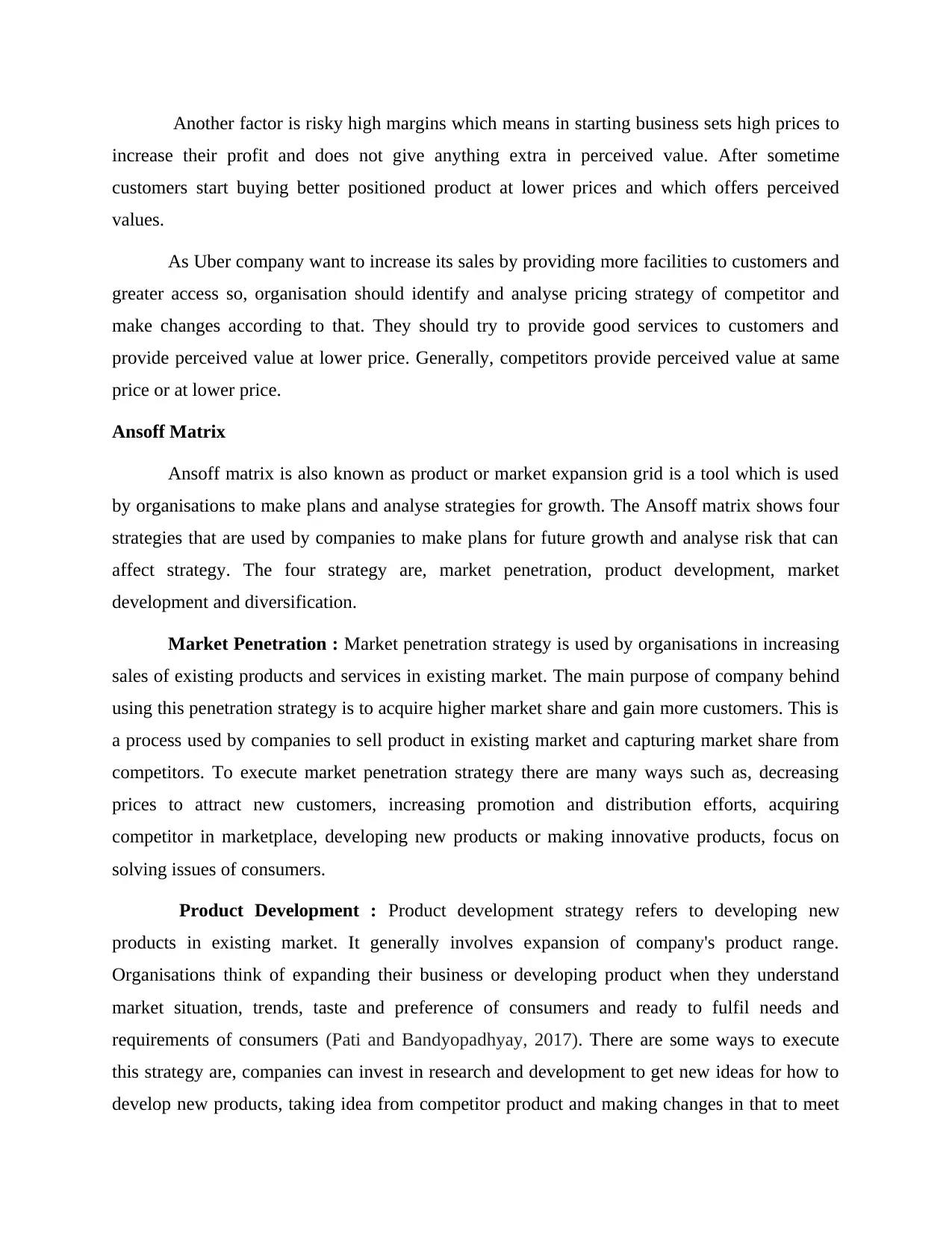
Another factor is risky high margins which means in starting business sets high prices to
increase their profit and does not give anything extra in perceived value. After sometime
customers start buying better positioned product at lower prices and which offers perceived
values.
As Uber company want to increase its sales by providing more facilities to customers and
greater access so, organisation should identify and analyse pricing strategy of competitor and
make changes according to that. They should try to provide good services to customers and
provide perceived value at lower price. Generally, competitors provide perceived value at same
price or at lower price.
Ansoff Matrix
Ansoff matrix is also known as product or market expansion grid is a tool which is used
by organisations to make plans and analyse strategies for growth. The Ansoff matrix shows four
strategies that are used by companies to make plans for future growth and analyse risk that can
affect strategy. The four strategy are, market penetration, product development, market
development and diversification.
Market Penetration : Market penetration strategy is used by organisations in increasing
sales of existing products and services in existing market. The main purpose of company behind
using this penetration strategy is to acquire higher market share and gain more customers. This is
a process used by companies to sell product in existing market and capturing market share from
competitors. To execute market penetration strategy there are many ways such as, decreasing
prices to attract new customers, increasing promotion and distribution efforts, acquiring
competitor in marketplace, developing new products or making innovative products, focus on
solving issues of consumers.
Product Development : Product development strategy refers to developing new
products in existing market. It generally involves expansion of company's product range.
Organisations think of expanding their business or developing product when they understand
market situation, trends, taste and preference of consumers and ready to fulfil needs and
requirements of consumers (Pati and Bandyopadhyay, 2017). There are some ways to execute
this strategy are, companies can invest in research and development to get new ideas for how to
develop new products, taking idea from competitor product and making changes in that to meet
increase their profit and does not give anything extra in perceived value. After sometime
customers start buying better positioned product at lower prices and which offers perceived
values.
As Uber company want to increase its sales by providing more facilities to customers and
greater access so, organisation should identify and analyse pricing strategy of competitor and
make changes according to that. They should try to provide good services to customers and
provide perceived value at lower price. Generally, competitors provide perceived value at same
price or at lower price.
Ansoff Matrix
Ansoff matrix is also known as product or market expansion grid is a tool which is used
by organisations to make plans and analyse strategies for growth. The Ansoff matrix shows four
strategies that are used by companies to make plans for future growth and analyse risk that can
affect strategy. The four strategy are, market penetration, product development, market
development and diversification.
Market Penetration : Market penetration strategy is used by organisations in increasing
sales of existing products and services in existing market. The main purpose of company behind
using this penetration strategy is to acquire higher market share and gain more customers. This is
a process used by companies to sell product in existing market and capturing market share from
competitors. To execute market penetration strategy there are many ways such as, decreasing
prices to attract new customers, increasing promotion and distribution efforts, acquiring
competitor in marketplace, developing new products or making innovative products, focus on
solving issues of consumers.
Product Development : Product development strategy refers to developing new
products in existing market. It generally involves expansion of company's product range.
Organisations think of expanding their business or developing product when they understand
market situation, trends, taste and preference of consumers and ready to fulfil needs and
requirements of consumers (Pati and Bandyopadhyay, 2017). There are some ways to execute
this strategy are, companies can invest in research and development to get new ideas for how to
develop new products, taking idea from competitor product and making changes in that to meet
Secure Best Marks with AI Grader
Need help grading? Try our AI Grader for instant feedback on your assignments.
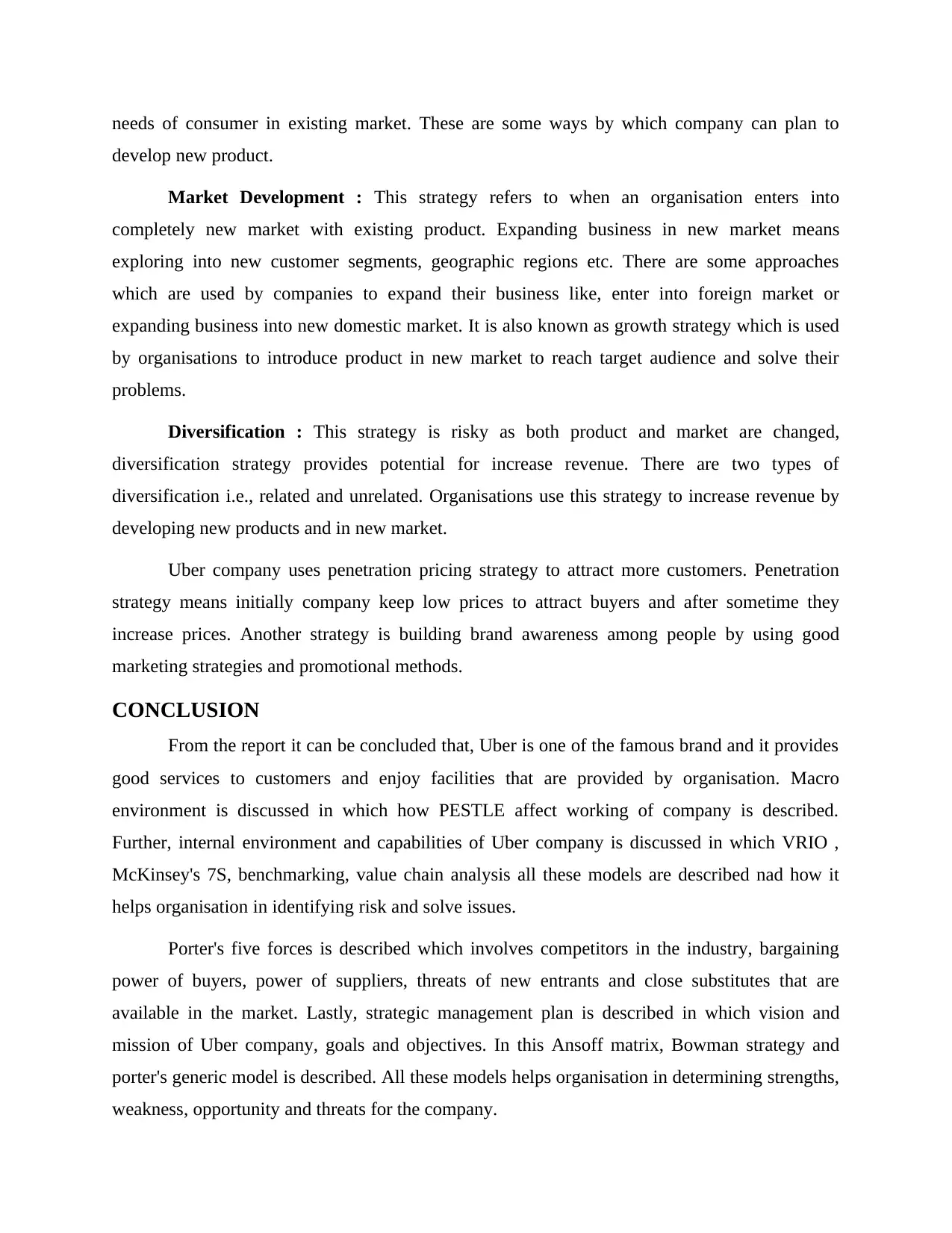
needs of consumer in existing market. These are some ways by which company can plan to
develop new product.
Market Development : This strategy refers to when an organisation enters into
completely new market with existing product. Expanding business in new market means
exploring into new customer segments, geographic regions etc. There are some approaches
which are used by companies to expand their business like, enter into foreign market or
expanding business into new domestic market. It is also known as growth strategy which is used
by organisations to introduce product in new market to reach target audience and solve their
problems.
Diversification : This strategy is risky as both product and market are changed,
diversification strategy provides potential for increase revenue. There are two types of
diversification i.e., related and unrelated. Organisations use this strategy to increase revenue by
developing new products and in new market.
Uber company uses penetration pricing strategy to attract more customers. Penetration
strategy means initially company keep low prices to attract buyers and after sometime they
increase prices. Another strategy is building brand awareness among people by using good
marketing strategies and promotional methods.
CONCLUSION
From the report it can be concluded that, Uber is one of the famous brand and it provides
good services to customers and enjoy facilities that are provided by organisation. Macro
environment is discussed in which how PESTLE affect working of company is described.
Further, internal environment and capabilities of Uber company is discussed in which VRIO ,
McKinsey's 7S, benchmarking, value chain analysis all these models are described nad how it
helps organisation in identifying risk and solve issues.
Porter's five forces is described which involves competitors in the industry, bargaining
power of buyers, power of suppliers, threats of new entrants and close substitutes that are
available in the market. Lastly, strategic management plan is described in which vision and
mission of Uber company, goals and objectives. In this Ansoff matrix, Bowman strategy and
porter's generic model is described. All these models helps organisation in determining strengths,
weakness, opportunity and threats for the company.
develop new product.
Market Development : This strategy refers to when an organisation enters into
completely new market with existing product. Expanding business in new market means
exploring into new customer segments, geographic regions etc. There are some approaches
which are used by companies to expand their business like, enter into foreign market or
expanding business into new domestic market. It is also known as growth strategy which is used
by organisations to introduce product in new market to reach target audience and solve their
problems.
Diversification : This strategy is risky as both product and market are changed,
diversification strategy provides potential for increase revenue. There are two types of
diversification i.e., related and unrelated. Organisations use this strategy to increase revenue by
developing new products and in new market.
Uber company uses penetration pricing strategy to attract more customers. Penetration
strategy means initially company keep low prices to attract buyers and after sometime they
increase prices. Another strategy is building brand awareness among people by using good
marketing strategies and promotional methods.
CONCLUSION
From the report it can be concluded that, Uber is one of the famous brand and it provides
good services to customers and enjoy facilities that are provided by organisation. Macro
environment is discussed in which how PESTLE affect working of company is described.
Further, internal environment and capabilities of Uber company is discussed in which VRIO ,
McKinsey's 7S, benchmarking, value chain analysis all these models are described nad how it
helps organisation in identifying risk and solve issues.
Porter's five forces is described which involves competitors in the industry, bargaining
power of buyers, power of suppliers, threats of new entrants and close substitutes that are
available in the market. Lastly, strategic management plan is described in which vision and
mission of Uber company, goals and objectives. In this Ansoff matrix, Bowman strategy and
porter's generic model is described. All these models helps organisation in determining strengths,
weakness, opportunity and threats for the company.
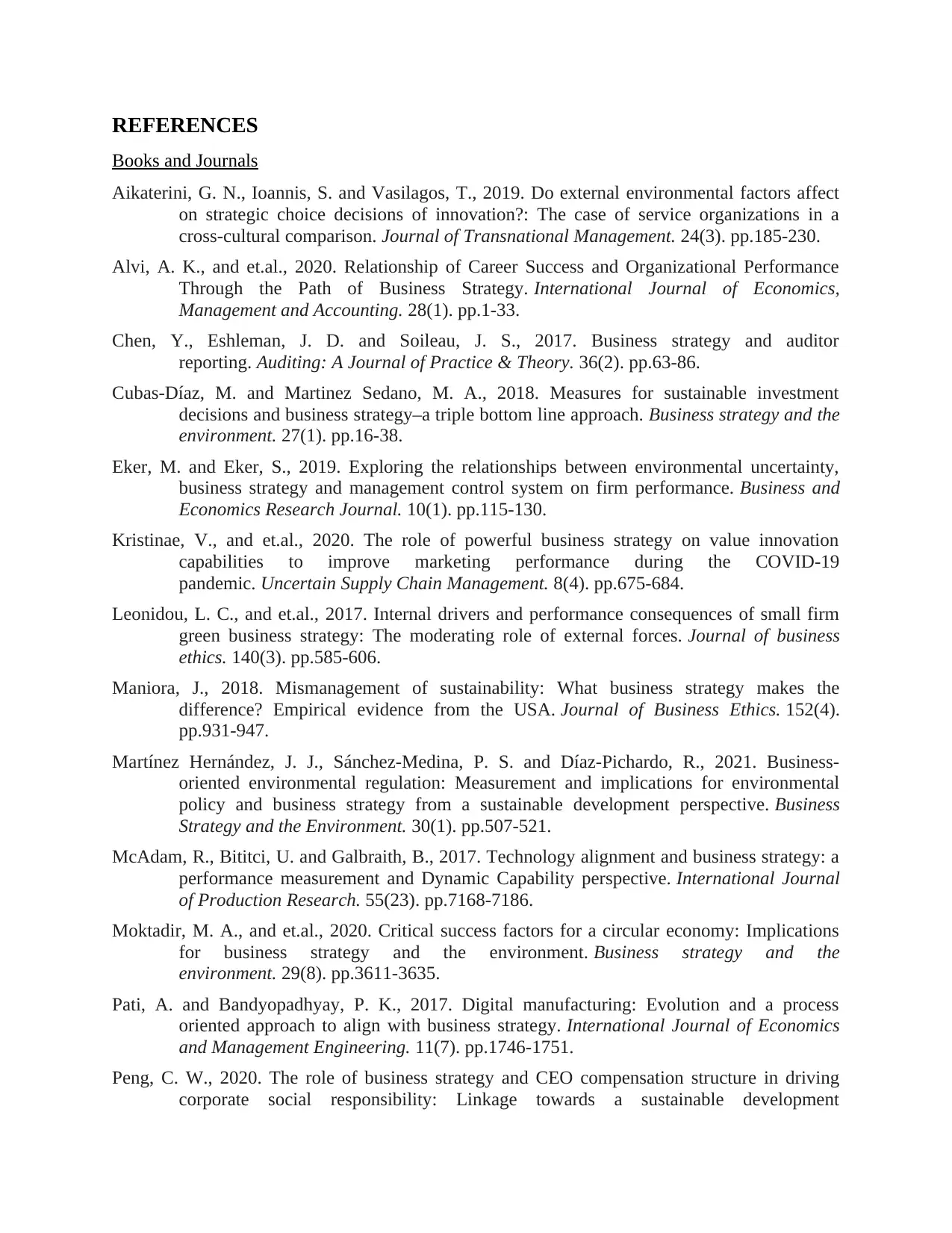
REFERENCES
Books and Journals
Aikaterini, G. N., Ioannis, S. and Vasilagos, T., 2019. Do external environmental factors affect
on strategic choice decisions of innovation?: The case of service organizations in a
cross-cultural comparison. Journal of Transnational Management. 24(3). pp.185-230.
Alvi, A. K., and et.al., 2020. Relationship of Career Success and Organizational Performance
Through the Path of Business Strategy. International Journal of Economics,
Management and Accounting. 28(1). pp.1-33.
Chen, Y., Eshleman, J. D. and Soileau, J. S., 2017. Business strategy and auditor
reporting. Auditing: A Journal of Practice & Theory. 36(2). pp.63-86.
Cubas‐Díaz, M. and Martinez Sedano, M. A., 2018. Measures for sustainable investment
decisions and business strategy–a triple bottom line approach. Business strategy and the
environment. 27(1). pp.16-38.
Eker, M. and Eker, S., 2019. Exploring the relationships between environmental uncertainty,
business strategy and management control system on firm performance. Business and
Economics Research Journal. 10(1). pp.115-130.
Kristinae, V., and et.al., 2020. The role of powerful business strategy on value innovation
capabilities to improve marketing performance during the COVID-19
pandemic. Uncertain Supply Chain Management. 8(4). pp.675-684.
Leonidou, L. C., and et.al., 2017. Internal drivers and performance consequences of small firm
green business strategy: The moderating role of external forces. Journal of business
ethics. 140(3). pp.585-606.
Maniora, J., 2018. Mismanagement of sustainability: What business strategy makes the
difference? Empirical evidence from the USA. Journal of Business Ethics. 152(4).
pp.931-947.
Martínez Hernández, J. J., Sánchez‐Medina, P. S. and Díaz‐Pichardo, R., 2021. Business‐
oriented environmental regulation: Measurement and implications for environmental
policy and business strategy from a sustainable development perspective. Business
Strategy and the Environment. 30(1). pp.507-521.
McAdam, R., Bititci, U. and Galbraith, B., 2017. Technology alignment and business strategy: a
performance measurement and Dynamic Capability perspective. International Journal
of Production Research. 55(23). pp.7168-7186.
Moktadir, M. A., and et.al., 2020. Critical success factors for a circular economy: Implications
for business strategy and the environment. Business strategy and the
environment. 29(8). pp.3611-3635.
Pati, A. and Bandyopadhyay, P. K., 2017. Digital manufacturing: Evolution and a process
oriented approach to align with business strategy. International Journal of Economics
and Management Engineering. 11(7). pp.1746-1751.
Peng, C. W., 2020. The role of business strategy and CEO compensation structure in driving
corporate social responsibility: Linkage towards a sustainable development
Books and Journals
Aikaterini, G. N., Ioannis, S. and Vasilagos, T., 2019. Do external environmental factors affect
on strategic choice decisions of innovation?: The case of service organizations in a
cross-cultural comparison. Journal of Transnational Management. 24(3). pp.185-230.
Alvi, A. K., and et.al., 2020. Relationship of Career Success and Organizational Performance
Through the Path of Business Strategy. International Journal of Economics,
Management and Accounting. 28(1). pp.1-33.
Chen, Y., Eshleman, J. D. and Soileau, J. S., 2017. Business strategy and auditor
reporting. Auditing: A Journal of Practice & Theory. 36(2). pp.63-86.
Cubas‐Díaz, M. and Martinez Sedano, M. A., 2018. Measures for sustainable investment
decisions and business strategy–a triple bottom line approach. Business strategy and the
environment. 27(1). pp.16-38.
Eker, M. and Eker, S., 2019. Exploring the relationships between environmental uncertainty,
business strategy and management control system on firm performance. Business and
Economics Research Journal. 10(1). pp.115-130.
Kristinae, V., and et.al., 2020. The role of powerful business strategy on value innovation
capabilities to improve marketing performance during the COVID-19
pandemic. Uncertain Supply Chain Management. 8(4). pp.675-684.
Leonidou, L. C., and et.al., 2017. Internal drivers and performance consequences of small firm
green business strategy: The moderating role of external forces. Journal of business
ethics. 140(3). pp.585-606.
Maniora, J., 2018. Mismanagement of sustainability: What business strategy makes the
difference? Empirical evidence from the USA. Journal of Business Ethics. 152(4).
pp.931-947.
Martínez Hernández, J. J., Sánchez‐Medina, P. S. and Díaz‐Pichardo, R., 2021. Business‐
oriented environmental regulation: Measurement and implications for environmental
policy and business strategy from a sustainable development perspective. Business
Strategy and the Environment. 30(1). pp.507-521.
McAdam, R., Bititci, U. and Galbraith, B., 2017. Technology alignment and business strategy: a
performance measurement and Dynamic Capability perspective. International Journal
of Production Research. 55(23). pp.7168-7186.
Moktadir, M. A., and et.al., 2020. Critical success factors for a circular economy: Implications
for business strategy and the environment. Business strategy and the
environment. 29(8). pp.3611-3635.
Pati, A. and Bandyopadhyay, P. K., 2017. Digital manufacturing: Evolution and a process
oriented approach to align with business strategy. International Journal of Economics
and Management Engineering. 11(7). pp.1746-1751.
Peng, C. W., 2020. The role of business strategy and CEO compensation structure in driving
corporate social responsibility: Linkage towards a sustainable development
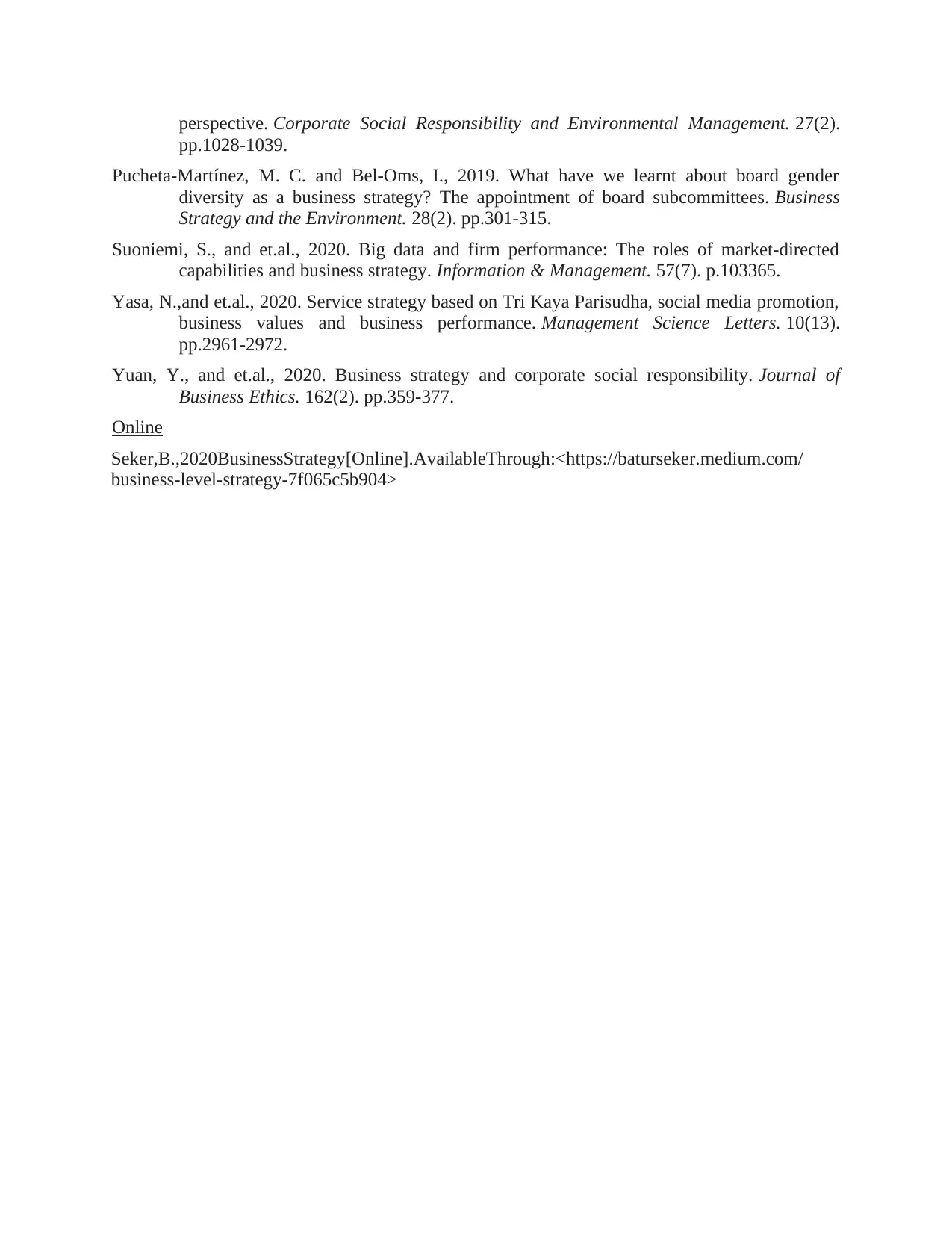
perspective. Corporate Social Responsibility and Environmental Management. 27(2).
pp.1028-1039.
Pucheta‐Martínez, M. C. and Bel‐Oms, I., 2019. What have we learnt about board gender
diversity as a business strategy? The appointment of board subcommittees. Business
Strategy and the Environment. 28(2). pp.301-315.
Suoniemi, S., and et.al., 2020. Big data and firm performance: The roles of market-directed
capabilities and business strategy. Information & Management. 57(7). p.103365.
Yasa, N.,and et.al., 2020. Service strategy based on Tri Kaya Parisudha, social media promotion,
business values and business performance. Management Science Letters. 10(13).
pp.2961-2972.
Yuan, Y., and et.al., 2020. Business strategy and corporate social responsibility. Journal of
Business Ethics. 162(2). pp.359-377.
Online
Seker,B.,2020BusinessStrategy[Online].AvailableThrough:<https://baturseker.medium.com/
business-level-strategy-7f065c5b904>
pp.1028-1039.
Pucheta‐Martínez, M. C. and Bel‐Oms, I., 2019. What have we learnt about board gender
diversity as a business strategy? The appointment of board subcommittees. Business
Strategy and the Environment. 28(2). pp.301-315.
Suoniemi, S., and et.al., 2020. Big data and firm performance: The roles of market-directed
capabilities and business strategy. Information & Management. 57(7). p.103365.
Yasa, N.,and et.al., 2020. Service strategy based on Tri Kaya Parisudha, social media promotion,
business values and business performance. Management Science Letters. 10(13).
pp.2961-2972.
Yuan, Y., and et.al., 2020. Business strategy and corporate social responsibility. Journal of
Business Ethics. 162(2). pp.359-377.
Online
Seker,B.,2020BusinessStrategy[Online].AvailableThrough:<https://baturseker.medium.com/
business-level-strategy-7f065c5b904>
Paraphrase This Document
Need a fresh take? Get an instant paraphrase of this document with our AI Paraphraser


1
1 out of 21
Related Documents
Your All-in-One AI-Powered Toolkit for Academic Success.
+13062052269
info@desklib.com
Available 24*7 on WhatsApp / Email
![[object Object]](/_next/static/media/star-bottom.7253800d.svg)
Unlock your academic potential
© 2024 | Zucol Services PVT LTD | All rights reserved.





